 Abraham Lincoln
If given the truth, the people can be depended upon to meet any national crisis...
Abraham Lincoln
If given the truth, the people can be depended upon to meet any national crisis...
 Guildford news...
for Guildford people, brought to you by Guildford reporters - Guildford's own news service
Guildford news...
for Guildford people, brought to you by Guildford reporters - Guildford's own news service
What Really Went On At Guildford As Steam Engines Were Withdrawn
Published on: 5 Jul, 2017
Updated on: 7 Jul, 2017
Fifty years have passed since steam locomotives were withdrawn from the Guildford area and the motive power depot, beside the entrance to the tunnel at the south end of the station, closed.
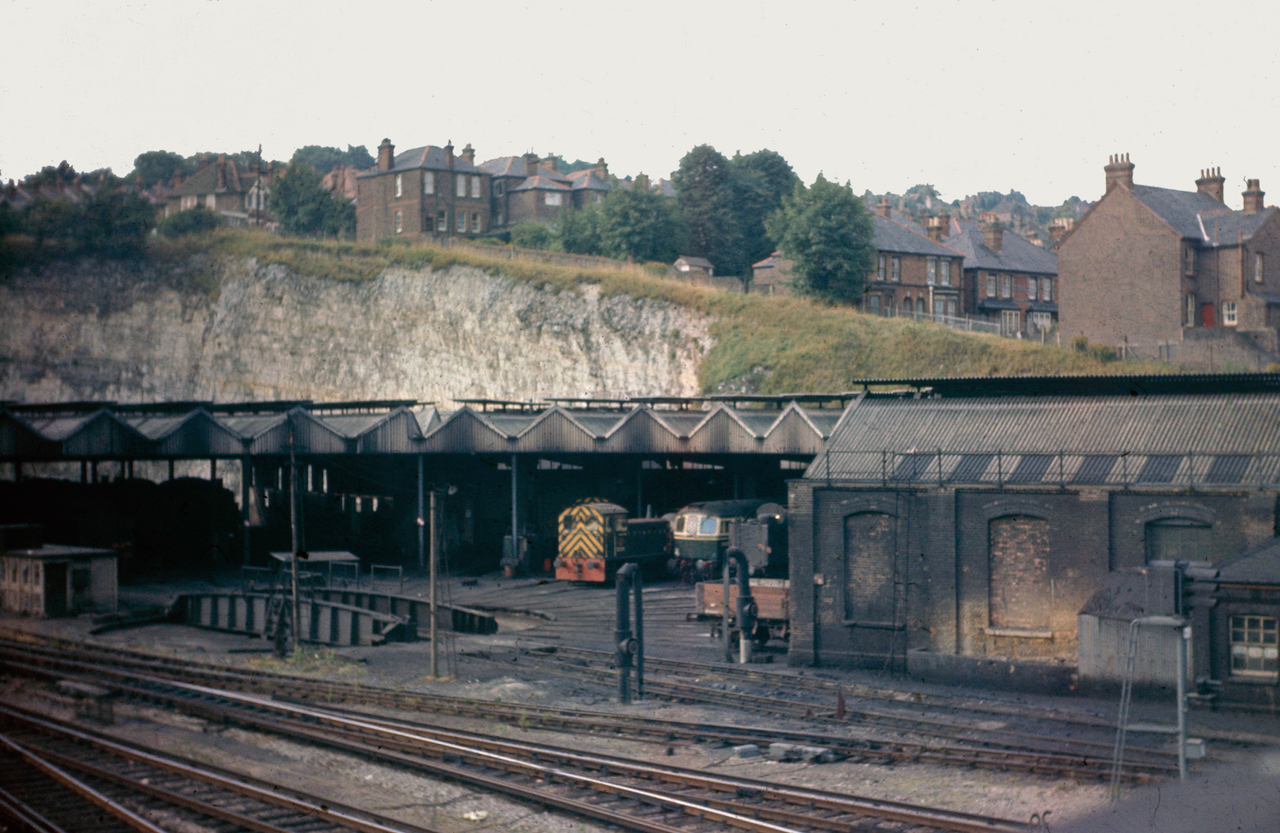
The Guildford Motive Power depot pictured by Dave Salmon in 1966. Geoff Burch collection. Click on all pictures to enlarge in a new window.
The depot, otherwise known as an engine shed, was once a hive of activity; and even as late as 1964 more than 150 men either worked in the shed or were based there.
Back then, many working practices on Britain’s railways were completely different to those of today.
Geoff Burch, a retired railwayman and now a railway author, started his career at Guildford’s motive power depot (MPD) in 1961. He was a fireman on one of the very last engines to leave the shed on July 9, 1967.
He has designed and raised funds for a commemorative plaque to record the depot and those who worked there. It will be officially unveiled on a wall at the pedestrian entrance to the Farnham Road multi-storey car park, now on the site of the depot, this Sunday (July 7) at 11am. Many former railwaymen will be attending to mark this historic milestone.
But what was going on during the last month of steam on the railways in the Guildford area back in 1967 – a period also known as the ‘summer of love’?
Here Geoff describes some of those working practices along with some fantastic period photographs.
Towards the end of steam on the Southern Region of British Railways, Guildford men didn’t have many regular turns involving the working of steam locomotives.

Deep ballast work between Woking and Brookwood on the up and down through lines. The train on the right is a down Bournemouth passenger service. Bob Hind collection.
However, to ensure the Bournemouth Electrification scheme finished on time, there were quite a number of special workings involving a lot of overtime.
It was commonplace to work shifts of 12 to 14 hours at a time (former railwayman Charlie Hampshire’s log books confirm this).

Passed Fireman Charlie Hampshire’s journal showing hours worked for June 2, 1967. It was a total of 13 hours 55 minutes!
It either involved working ballast or material trains to the site of work (anywhere between Brookwood and Basingstoke) and then getting relief by another crew in the night hours by taxi and the nearest bridge (climbing over fences and clambering down steep embankments to gain access to the track) or in daylight hours where trains were running, by walking to the nearest station and catching a train home.
The main line was quite often completely blocked at weekends and this would mean that trains would either be diverted via Guildford and Havant or via Alton and Winchester Junction (part of which is now termed the Mid-Hants Railway).
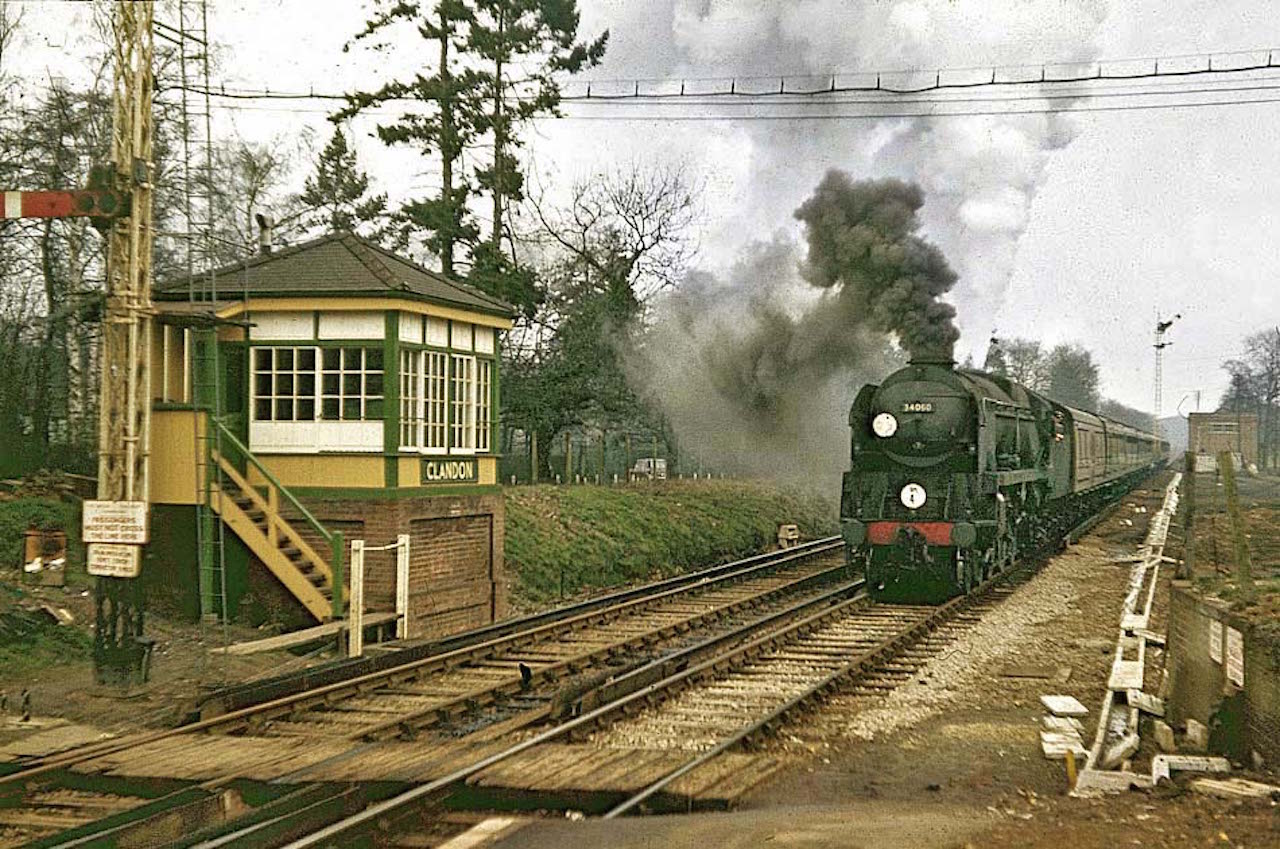
Bulleid Pacific Battle of Britain Class No. 34060 ‘25 Squadron‘ being diverted via the New Line at Clandon.
Because of lack of route knowledge, quite a number of Guildford drivers would be booked to conduct Bournemouth, Salisbury or Nine Elms (London) crews over these routes.
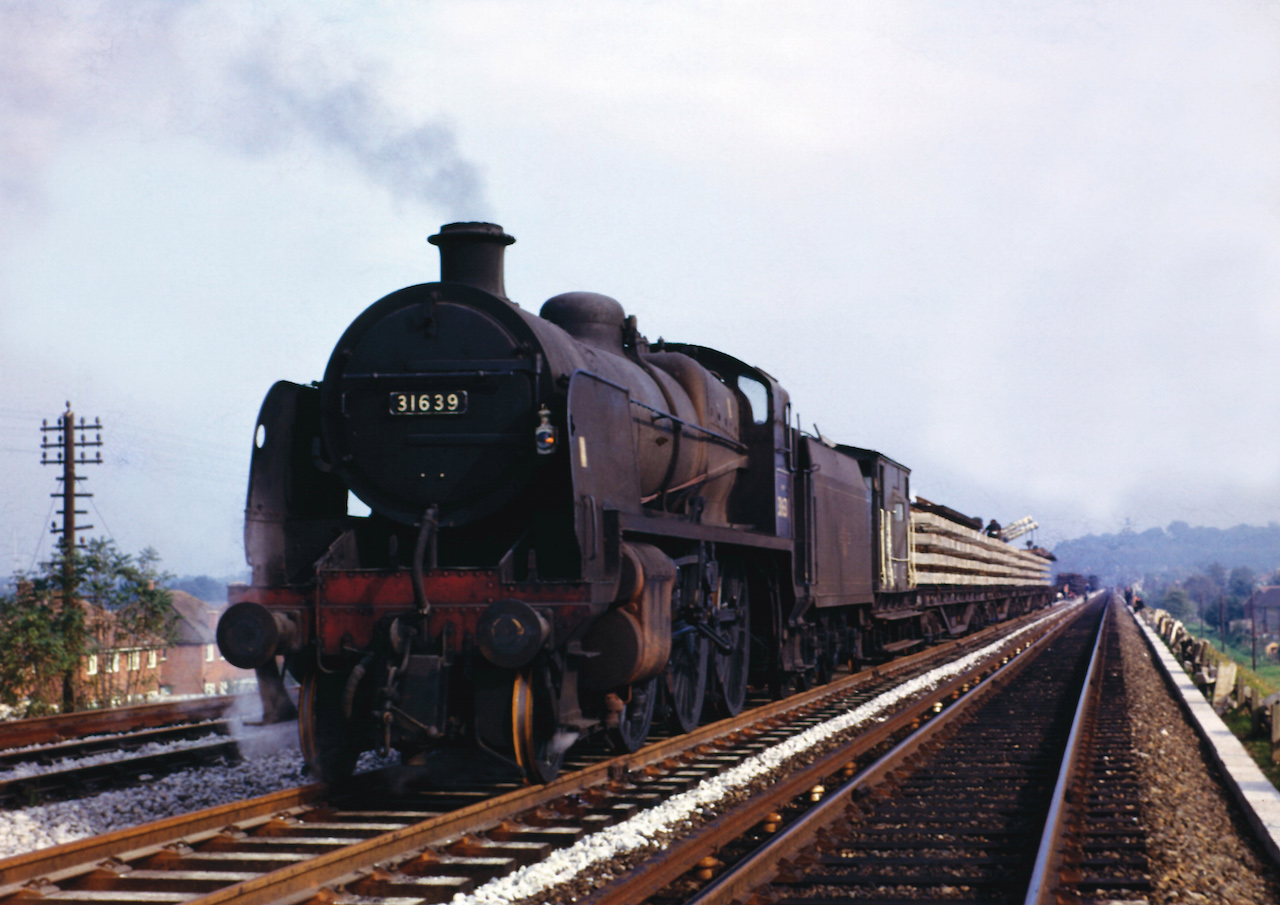
U Class No.31639 with a ballast train and sections of new rails and concrete sleepers pictured at Farnborough. Geoff Ball collection.
Other steam locomotive turns were passenger, van trains or ballast train services were mainly covered by BR Standard Class 4MT or 5MT locomotives.
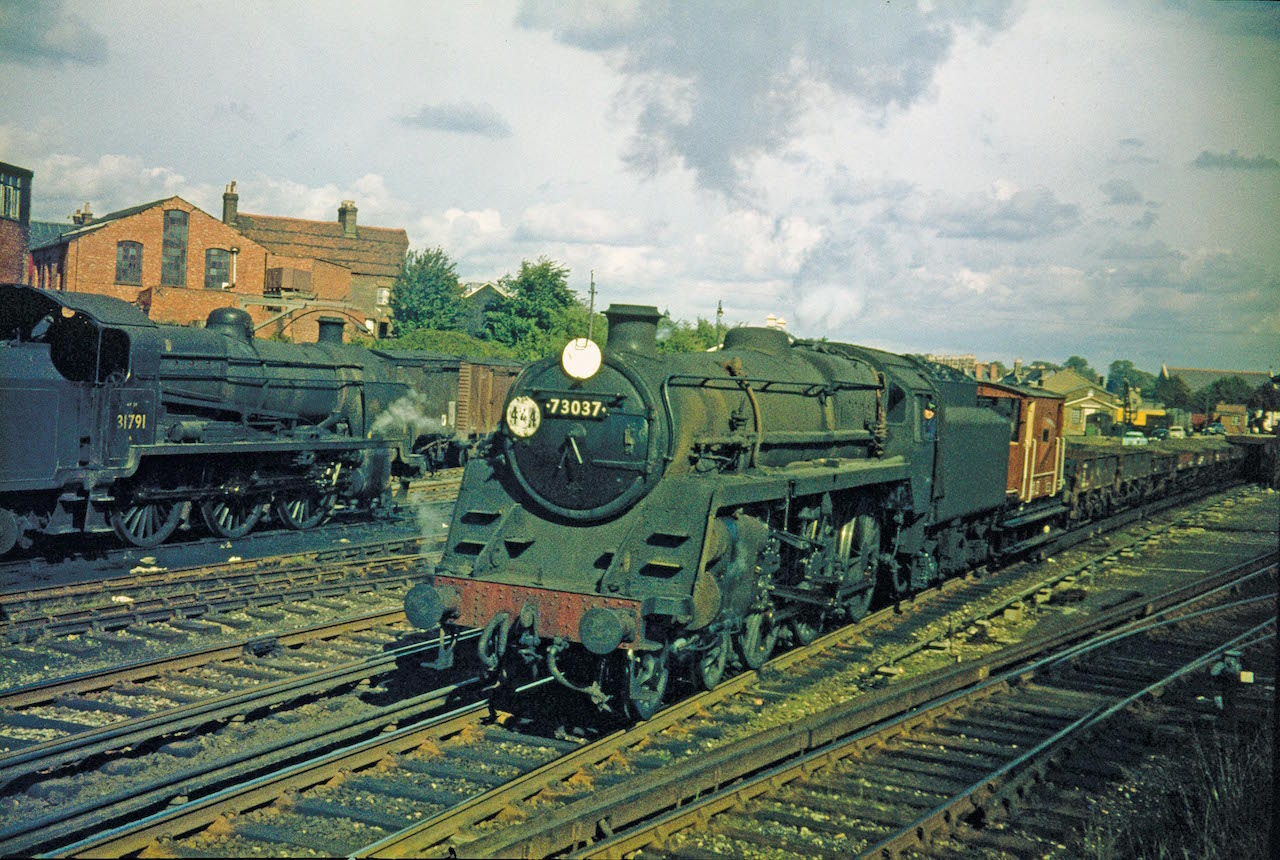
Spoil train (dirty ballast) passing Aldershot Yard heading for Farnham Tip, with Driver Pat Kinsella at the controls. Picture Mick Foster collection.
Dirty ballast that had been cleaned from the trackbed from various sites was transported to Farnham Tip; the empty wagons being returned to the work sites to be filled again.
Prior to the Guildford shed closing, other staff would have still been employed; fitters, boilersmiths, boilerwashers, toolmen and general labourers. Doubling up in some cases to perform other duties. For example, the storeman apart from issuing materials from the stores would also be utilised in the running foreman’s office as a timekeeper.
Some of the drivers also took on the role of acting running foremen.
On Sunday, April 30, 1967, it was observed that the following steam locomotives were at Guildford:
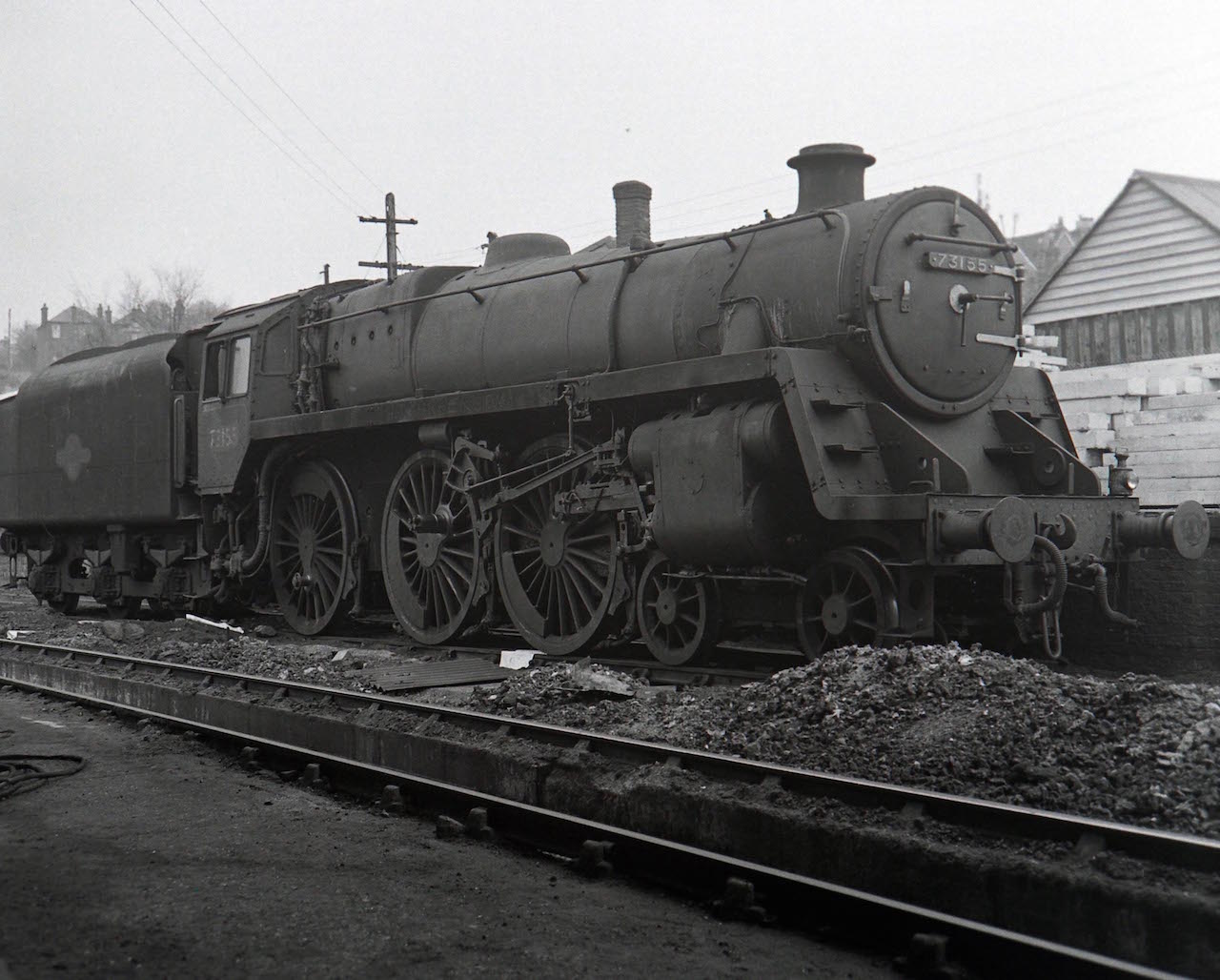
No. 73155 without its connecting rods at the Back Road, Guildford, pictured by Dave Salmon. Geoff Burch collection.
In the Back Road, (coaling stage) BR Standard Class 5MT 73155 (with *rods removed and placed in firebox).
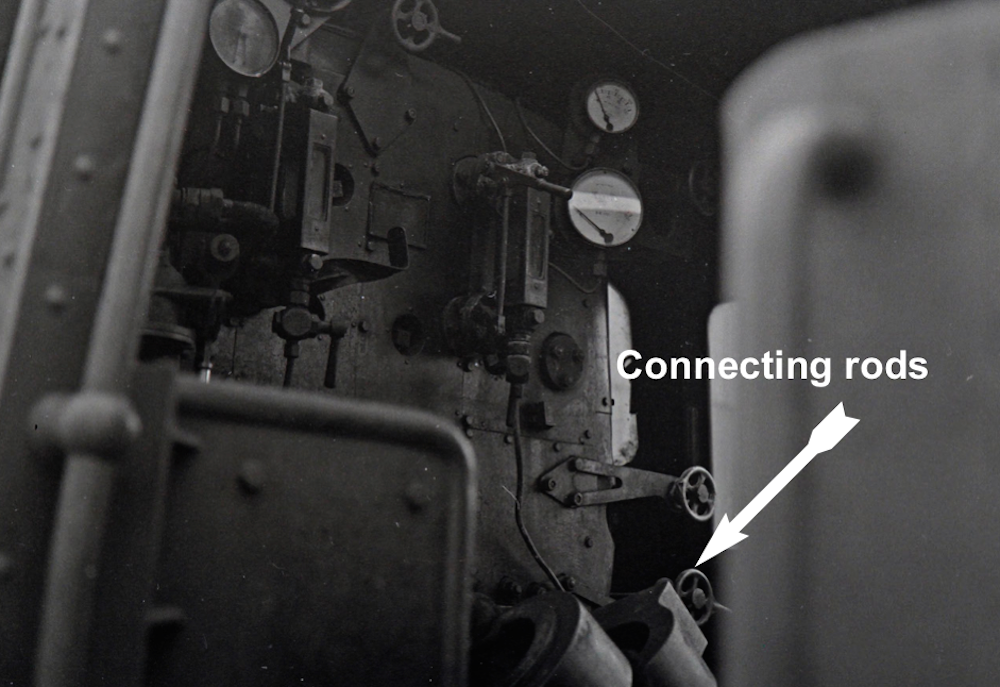
Looking into the cab of No. 73155, with the connecting rods seen inside the firebox. Pictured by Dave Salmon. Geoff Burch collection.
*[A loco’s steel rods are ‘arms’ that convert the horizontal motion of the pistons into a rotation motion of its driving wheels.]
The interesting thing about BR Standard Class 5MT 73155 standing idle with her rods off is that the locomotive failed at Basingstoke on June 18, 1967. According to the foreman’s log book, on the June 29, 1967, Driver Stan Harms was booked to tow the locomotive back to Guildford for repair utilising 1550hp Type 3 ‘Crompton’ diesel-electric locomotive D6500, arriving at Guildford loco at 19.10. The connecting rods on 73155 would have been removed beforehand to ensure the pistons and valve gear remained inoperative as there wouldn’t be any lubrication without the engine being in steam.
The locomotive was subsequently repaired and re-entered service for the remainder of steam working on the Southern. I was the fireman on this locomotive on July 9, 1967; the final journey being to Salisbury to await its fate with the cutter’s torch at Barry, South Wales.
In the shed: USA Class 30072, BR Standard Class 4MT 76069 and 76031. BR Standard Class 5MT 73037, 73092, 73118, 73018 and 73093.
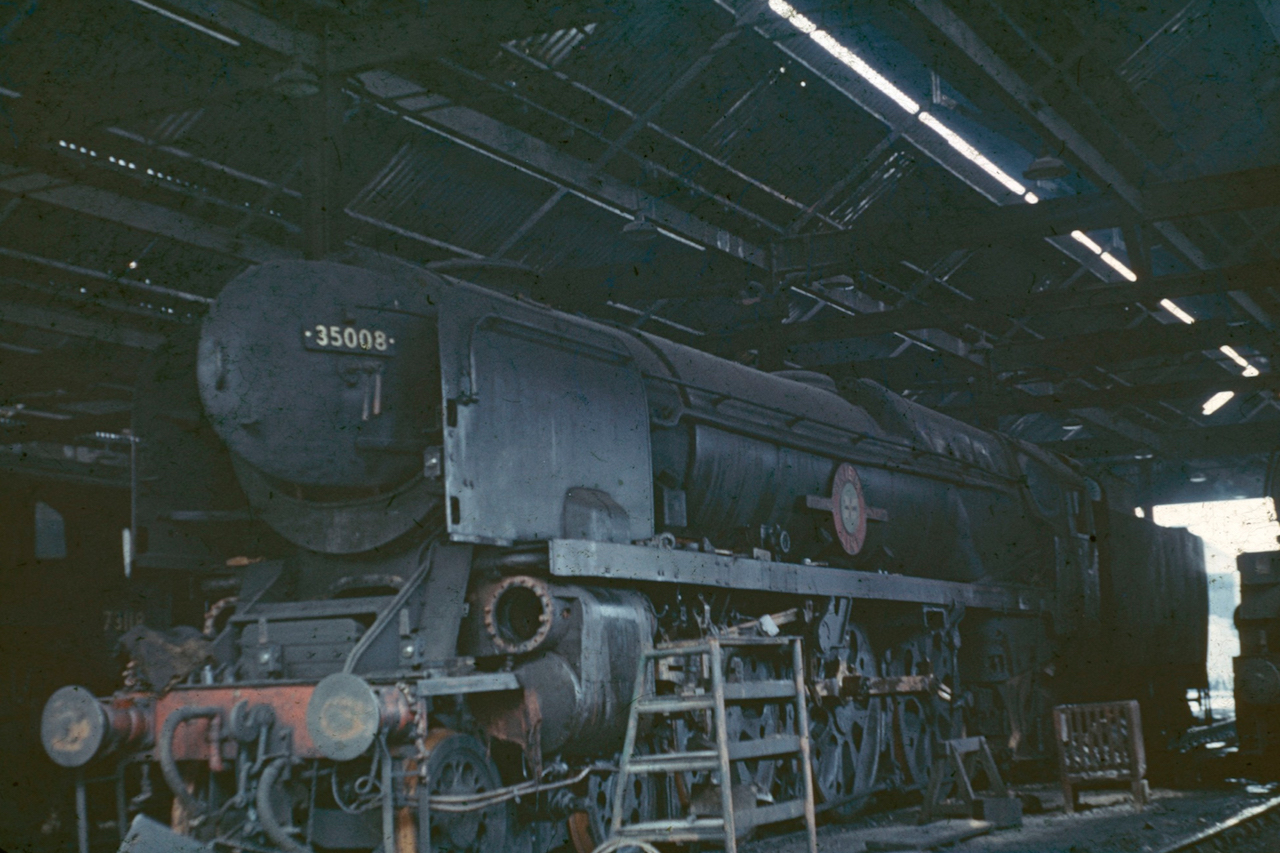
Bulleid rebuilt Pacific Merchant Navy Class No.35008 ‘Orient Line‘ undergoing repairs at Guildford. Picture George Woods collection.
There were quite a number of highly qualified fitting staff employed at Guildford MPD. Because of this expertise, you would sometimes see Bulleid Pacific locomotives being examined and repaired at Guildford shed.
Invariably, this work would be undertaken in No.2 Road of the ‘New Shed’ as this class of locomotive couldn’t be turned on the turntable because of their size.
The turntable would be set for No.2 Road which would allow the passage of locomotives from the ‘New Pit’ straight across the turntable to this area.
However, in certain circumstances, the tender would need to be split from the locomotive, the drawbar and various water, steam and vacuum couplings would also be parted and the engine or tender could then be moved by the shed shunting locomotive (USA Class 30072 being the last) to other areas of either the ‘New’ or ‘Old’ shed via the turntable.
There was one turn in which the Guildford crew would book on around 11am, prepare their locomotive, normally a BR Standard class or a Bulleid Pacific West Country or Battle of Britain class that had worked up from Salisbury earlier in the day with a stone train from Meldon Quarry.
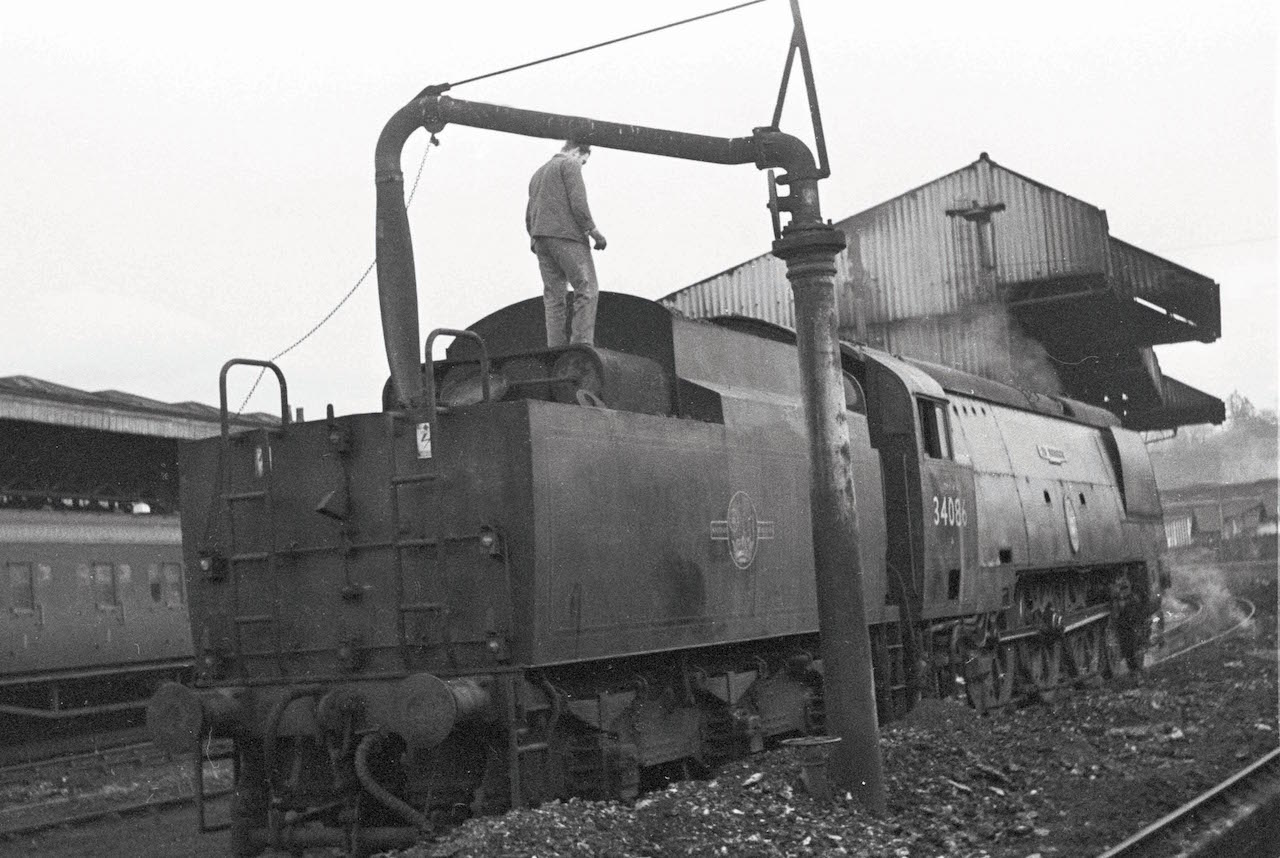
Geoff Burch on the tender of No.34086 as it takes water at Guildford. Picture by Dave Salmon. Geoff Burch collection.
The Bulleid Pacific locomotives would then have to be ‘turned’ via the triangle at Weybridge and Addlestone Junction to facilitate its ‘engine-first’ travel back to Salisbury as the turntable at Guildford wasn’t large enough to turn engines of this size.

Two Bulleid Pacifics at Guildford which would have be turned on the ‘triangle’ at Addlestone / Weybridge before returning to Salisbury..
Following preparation of the locomotive, they would then travel tender-first to Woking Down Yard and work the 13.02 stone train empties to Salisbury getting relief by a Salisbury crew who continued the journey to Meldon quarry.
The Guildford crew would then walk to Salisbury MPD and after refreshments, prepare their locomotive, pick up their empty coaching stock and work the 17.15 passenger service to Woking, getting relief by another Guildford crew and then make their way as passengers back to Guildford and sign off duty.
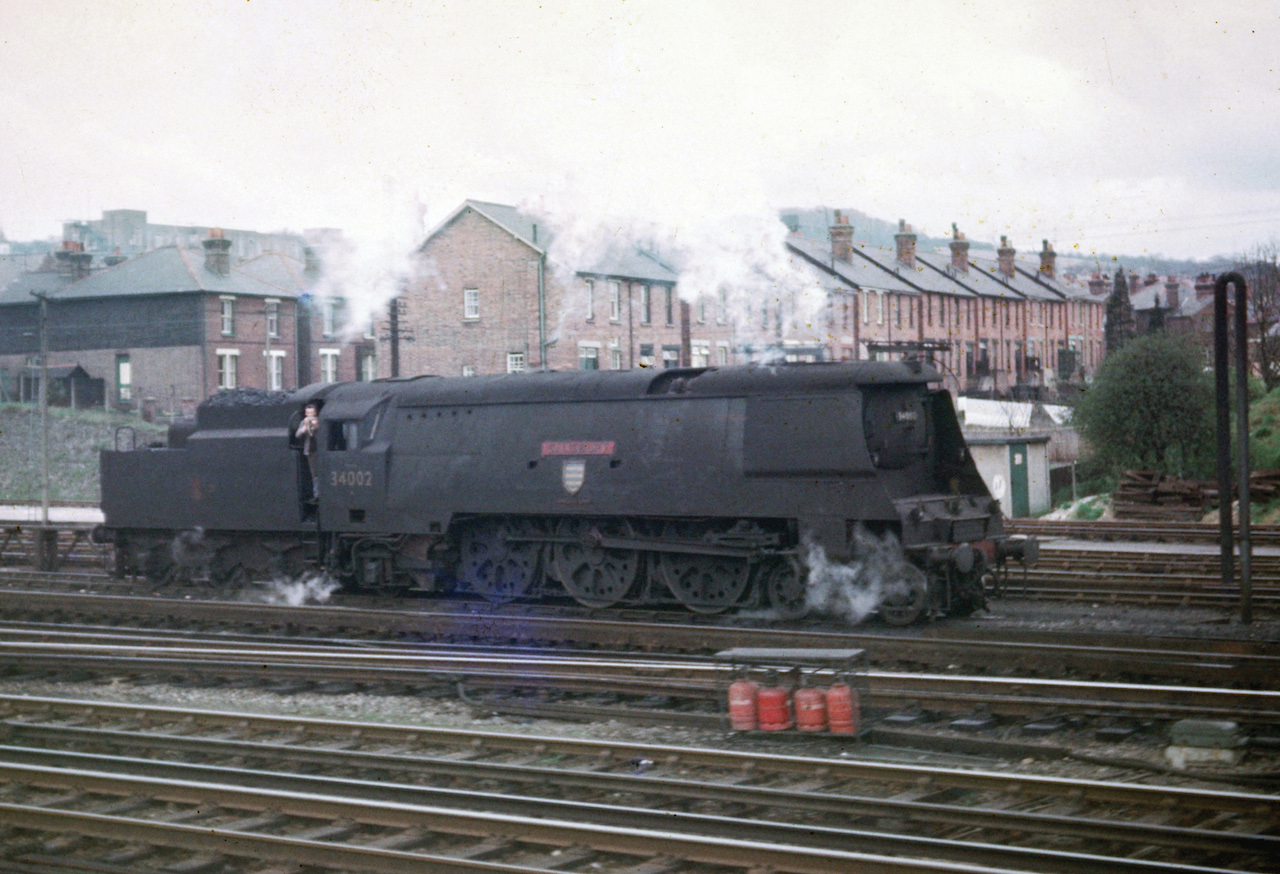
Geoff Burch on Bulleid Pacific West Country Class No.34002 ‘Salisbury’ leaving Guildford to turn the engine via the ‘triangle’ at Addlestone / Weybridge.
Another regular steam turn was the last Weymouth to Woking. Guildford men would work a passenger service to Basingstoke and then relieve the Up Weymouth service work back to Woking, placing the empty coaching stock in the sidings and then take the locomotive back to Guildford and dispose.
Looking through various log-books that have survived, I have been able to determine some of his last days of working at Guildford MPD, before I was transferred to Woking on Monday, July 10, 1967, following the depot’s closure the previous day.
One of the turns in the ‘Top Link’ at Guildford in the final months of steam working was to sign on, prepare the locomotive and then work a freight from Guildford Up Yard to Wokingham, calling at North Camp and Blackwater on the way. Once the shunting work had been completed at Wokingham, the locomotive would return ‘light-engine’ back to Guildford MPD.
On Saturday, January 21, 1967, the locomotive booked for the turn was BR Standard Class 3MT 77014. The driver was Stan Harms, I was the fireman.
The locomotive had arrived at Guildford MPD in March 1966 from Scotland. She wasn’t a particularly good locomotive, ‘leaked like a sieve’ and consequently wasn’t very free steaming.
After shunting was completed at Wokingham, a Guildford guard, Ray Ruffle, approached Stan Harms and asked if he’d be kind enough to give him (and his bike) a lift back to his home, which was situated near the railway line between Crowthorne and Sandhurst Halt.

The photo Ray Ruffle took of Stan and Geoff on No.77014 after they had dropped Ray off near his home at Sandhurst.
Stan was reluctant at first (he didn’t particularly like other people being on the footplate) but agreed after Ray said he’d take a few photographs and supply us with copies.
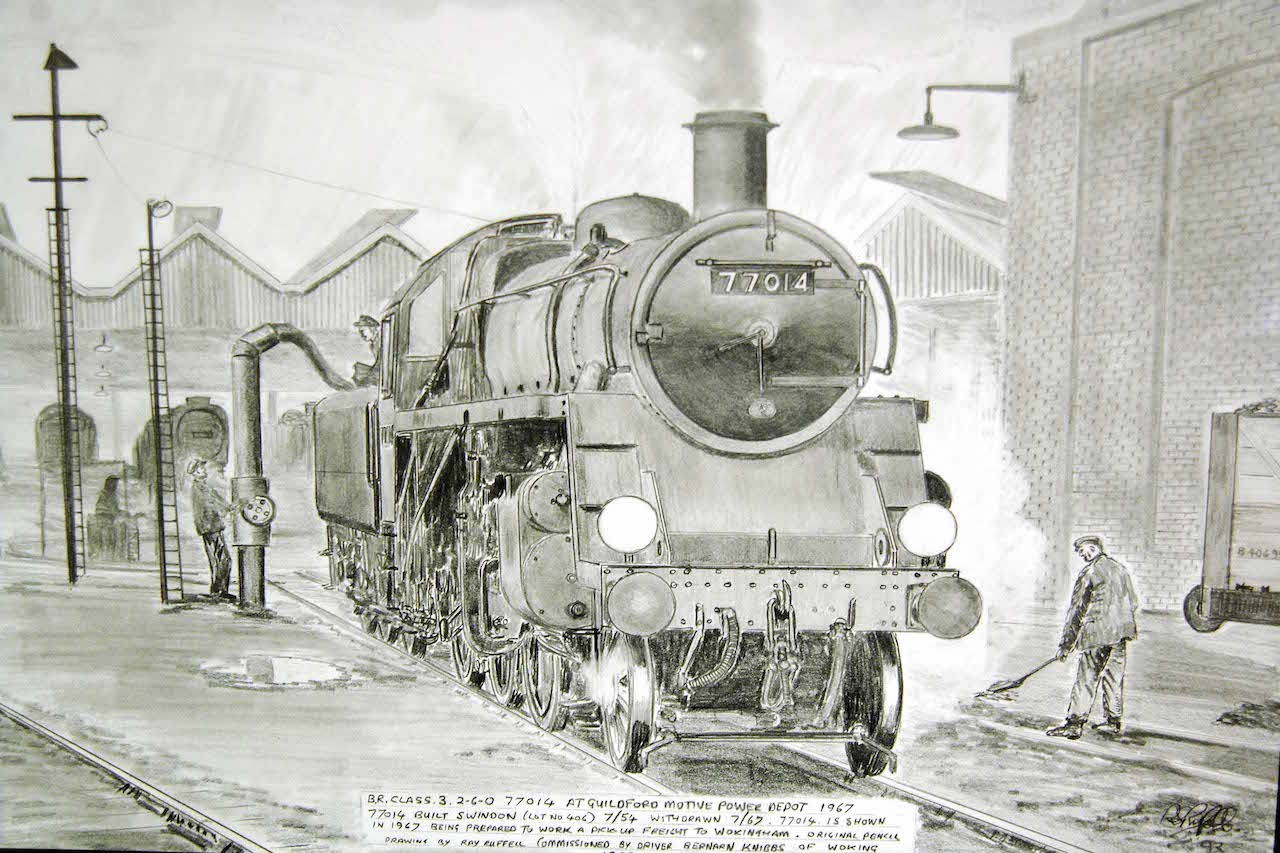
Ray Ruffell’s sketch of No. 77014 taking water at Guildford featuring driver Stan Harmes and fireman Geoff Burch.
The strange thing was that it wasn’t until 43 years later when I was doing some research for my first book The Ramblings of a Railwayman, and was talking to an old work colleague and fellow fireman Bernie Knibbs about the episode, I found out that the late Ray Ruffell had completed a pencil sketch of 77014 (plus Stan and me) as the engine was taking water before departing from Guildford MPD that very day!
Bernie Knibbs then showed me the framed drawing which he’d had specially commissioned and which now hangs in his upstairs landing. What a coincidence!
On Tuesday, June 27, 1967, I was booked as Spl. No. 171 duty with driver Stan Harms (who was my regular driver in the Top Link). We departed Guildford MPD at 20.45 with BR Standard Class 5MT 73020, and ran light-engine to Farnham Up Yard, arriving at 21.15. We then worked an empty ballast train from Farnham Up Yard to Surbiton at 21.50, arriving there at 23.30.
Then worked ‘as ordered’ within the possession to New Malden. The following morning, after the work was completed, we worked the train to Wimbledon West Yard arriving at 06.00. After running the engine around the train, we then worked it to Woking Down Yard arriving at 07.02. Finally we ran light-engine to Guildford (should have arrived at 07.41) the actual time being 08.45 and disposed the locomotive. The same turn was repeated the following evening (June 28) to the morning of June 29.
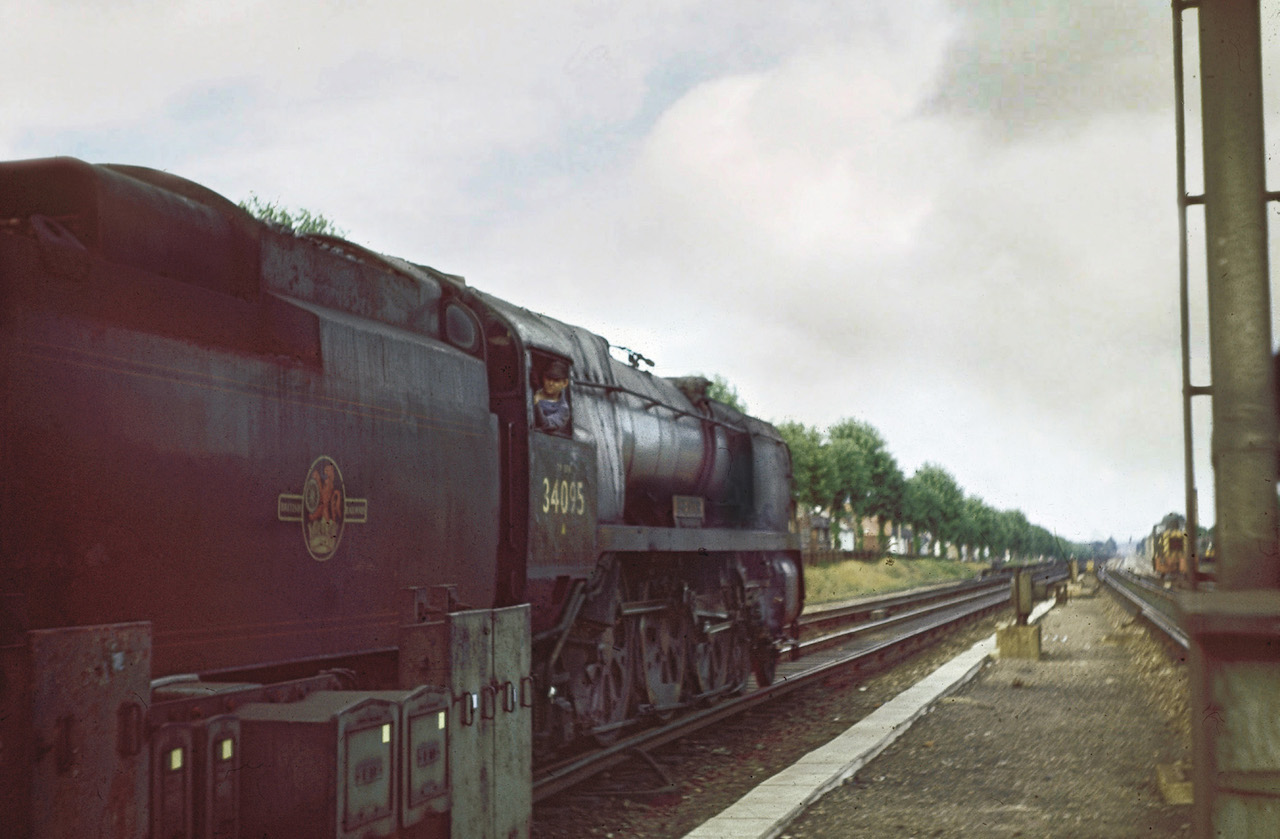
Bulleid Pacific West Country Class No.34095 ‘Brentor‘ at Woking. Pictured by Dave Salmon. Geoff Burch collection.
On Friday, June 30, Stan and I were booked Spl. No. 165 duty, but this time with a slight variation! After preparing our locomotive (this time BR Standard Class 5MT 73018), we left Guildford for Woking Yard but the engine failed shortly afterwards.
Rebuilt Bullied Pacific West Country class 34095 ‘Brentor’ was dispatched to the rescue, departing Guildford shed at 23.55 with driver Terry Aylesbury at the controls. The locomotives were swapped over and Stan and I continued the duty with 34095 ‘Brentor‘. In the meantime, the failed 73018 returned to Guildford shed with Driver Aylesbury. Stan and I were then relieved by Terry Aylesbury and his fireman at 03.00 at the site of work at Waterloo and we returned to Guildford by road transport.
On Saturday July 1, I was booked on duty at Guildford at 20.45 again with Stan to prepare our locomotive, BR Standard Class 4MT 76066, and work Special No. 165 duty. This entailed leaving the depot at 21.55 and travelling light-engine to Woking Up Yard and then working a ballast train to Waterloo working under possession from 23.50 until 07.30.
No relief was available, so we had no option but to continue with the duty, working the train back to Woking Up Yard arriving at 09.02. We then ran light-engine to Guildford arriving back at the following morning, Sunday, July 2, at 09.37, disposing the locomotive and booking off duty.
On Wednesday, July 4, I booked on duty 08.00 spare at Guildford with Stan Harms. We were then asked to prepare BR Standard Class 4MT 76066 and departed the depot at 09.40 light engine to Basingstoke via Woking, returning home on a passenger train.
With two days to go until the end of steam, I was booked with Stan on Special No. 529 Duty signing on at 11.51, preparing 1600/600hp electro-diesel E6028 and departed the depot at 12.15 to run light-engine to Guildford Up Yard. We then worked the 12.26 vans to Clapham Junction (via East Putney) and got relief at 14.35.
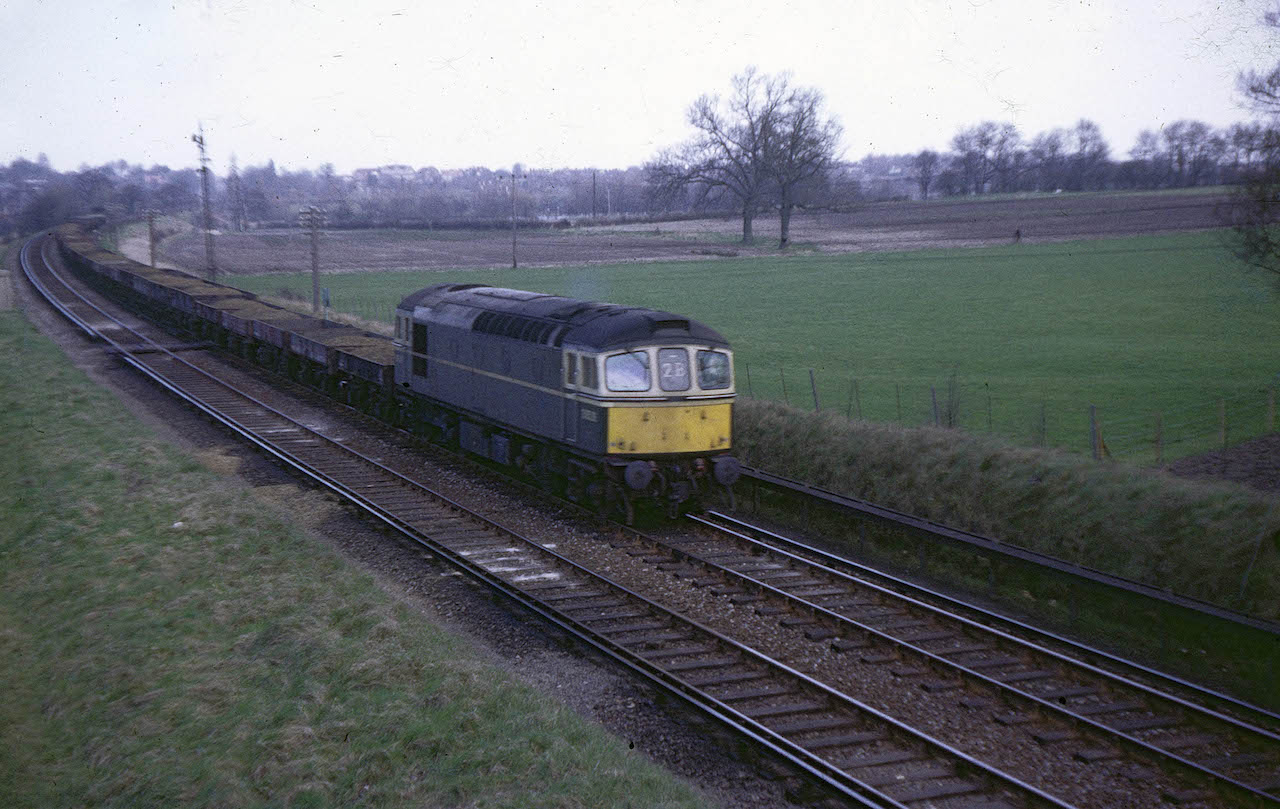
A ‘Crompton’ diesel pictured at Badshot Lea. Towards the end of steam drivers at Guildford had already been trained to work both replacement diesel and electro-diesel locomotives. Picture: Charles Green collection.
We then went as passengers to Waterloo, had our break, were then relieved, and after working the 15.44 vans (with a 1550hp Type 3 ‘Crompton’ diesel-electric locomotive) to Basingstoke, getting relief by another crew at 18.25. I was a home passenger to Guildford at 1837, and clocked off at 19.51.
On Sunday, July 9, 1967 (the final day of steam), I was booked as ‘Standby locos to Salisbury if required, etc.’ signing on duty at 08.00 with driver Doug Stent.
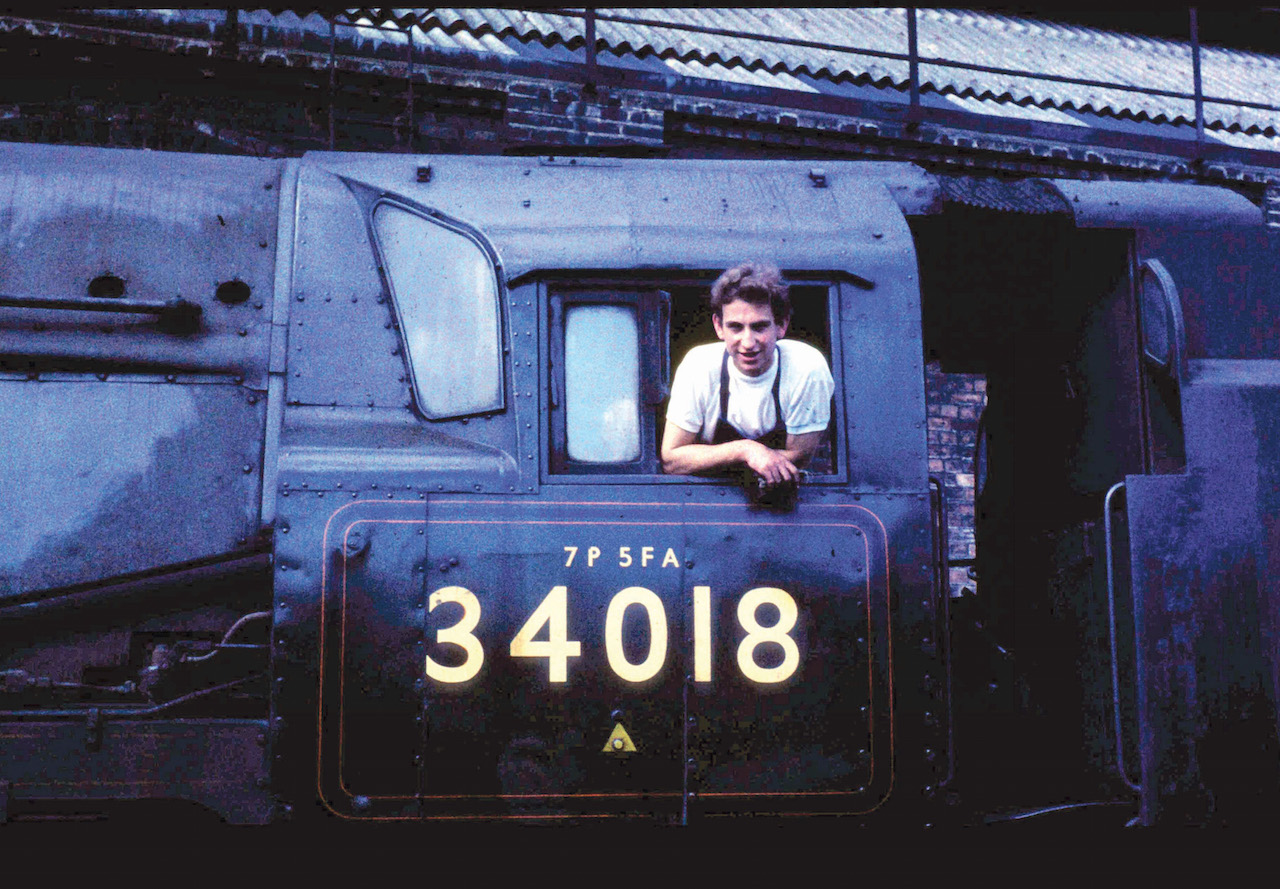
Passed Fireman Charlie Hampshire in the cab of No.34018 ‘Axminster‘ at Guildford on July 9, 1967. Geoff Burch collection.
Four steam locomotives remained at Guildford that final day: two BR Standard Class 5MTs, Nos. 73118 and 73155, Rebuilt Bullied Pacific West Country Class 34018 ‘Axminster’, and USA Class 30072.
Passed Fireman Bill Brain asked Doug Stent if he would like to swap turns which was agreed so the crews were: Bill Brain driving and me firing. We would be on 73155, while Pat Kinsella would be the fireman with Dave Elson on 73118. These locomotives would run coupled together to Salisbury MPD.
Bullied Pacific West Country Class 34018 ‘Axminster’ was crewed by Driver Dave Bunce and Passed Fireman Charlie Hampshire running light-engine to Salisbury MPD.
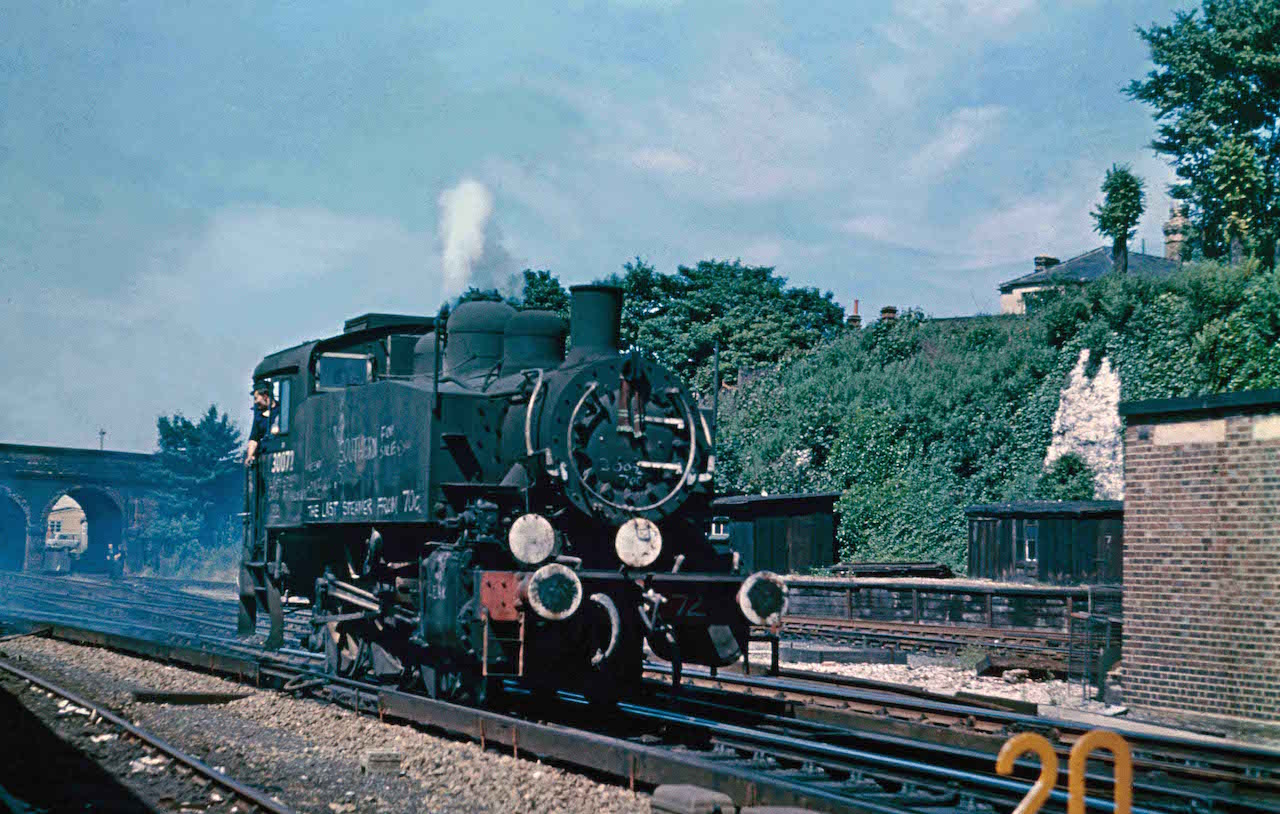
USA tank No.30072 is seen leaving Guildford on July 9, 1967. It was the last steam engine to go. Picture by Dave Salmon. Geoff Burch collection.
Finally, USA Class 30072 would run light-engine to Salisbury via Havant and Fratton (because there might be a shortage of coal and water on this long journey). The locomotive was worked by a Fratton crew.
I recall the trip to Salisbury as quite an emotional journey. On moving from the ‘Old Pit’ to the ‘Coal Stage’ at Guildford to couple to 73118, there were a large number of explosions! These were caused by a number of detonators being placed on the rail beneath the wheels of the locomotive.
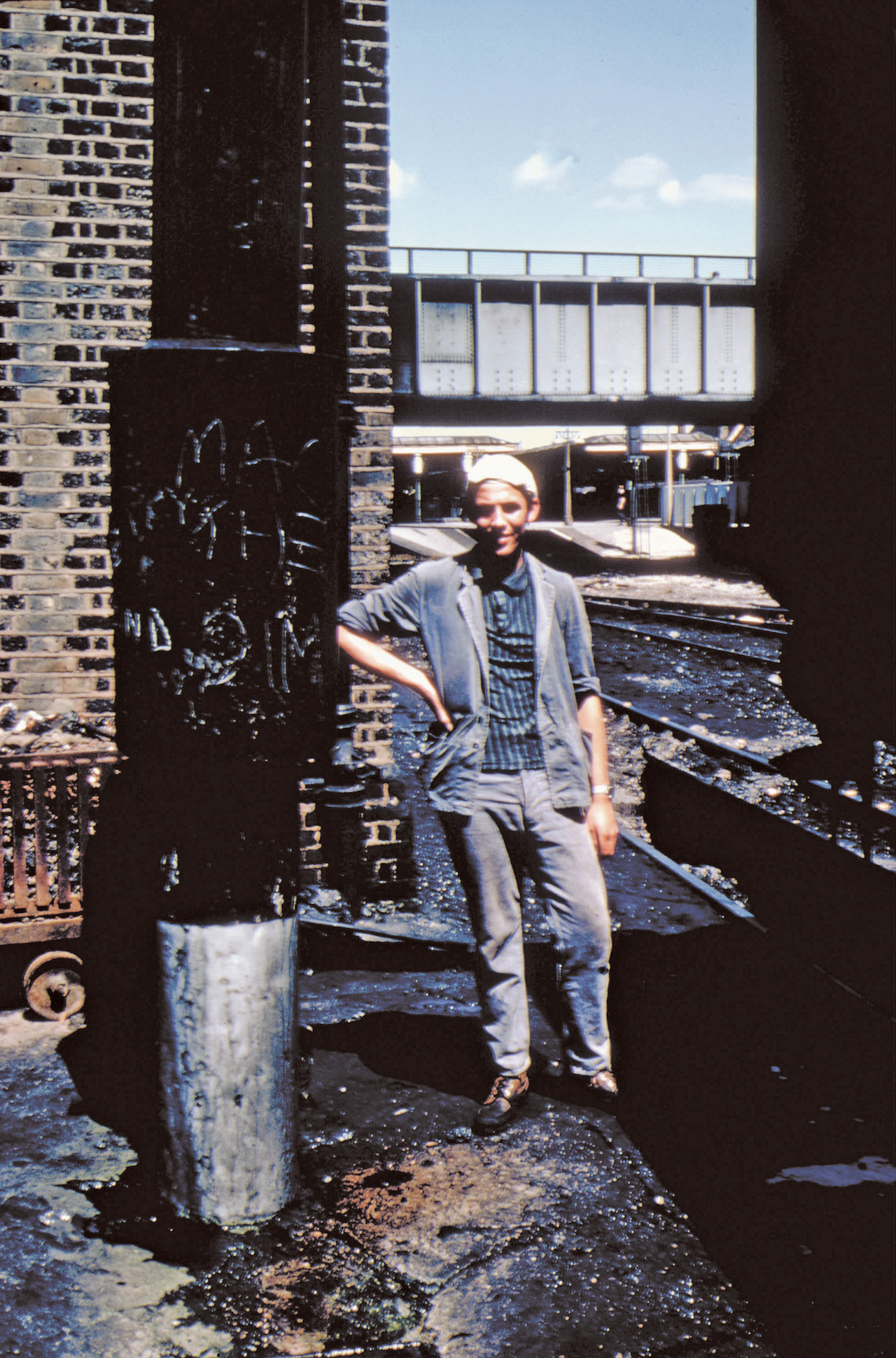
Geoff Burch at the water column having replenished the tender of No.73155, prior to departure on July 9, 1967. Geoff Burch collection.
On the way to Woking, and then to Salisbury, hundreds of people were on stations and bridges watching and waving – the whistles of both locomotives being used to good effect!
On reaching Grateley, the locomotives were stopped at the home signal in the platform.
As the signalman said we would be waiting a while for the signal to be cleared, it was decided that we would gain refreshment from the local pub nearby.
On reaching Salisbury MPD and dropping the fire, climbing down from the locomotive I remembering thinking it seemed very strange knowing that this would be the last time I would set foot on a steam locomotive in my railway career. It all seemed very surreal.
Alex McClymont (who was a fireman and passed fireman in my firing days), had the good sense to save the copy of the seniority list of drivers and firemen at Guildford MPD which had been posted in the notice case in 1964. The list of names totalled 86 drivers and 73 firemen. But of course, some of the drivers and firemen that I’d met when I started my firing career in 1962, had already retired, passed away or moved to other depots.

The stores hatch and notice boards inside Guildford MPD, pictured by Dave Salmon. Geoff Burch collection. Note the clock standing at 12.35.
Of the other staff who were there in those final days working various shifts: were the shedmaster and four clerks, four running foremen, three non-clerical timekeepers, around six engine cleaners, two boiler washers, three men who turned the engines on the turntable, about six fitters, the three who formed the breakdown crane staff, four in the boilersmith’s shop, four labourers (including those who coaled the engines, four who worked in the stores and one man whose sole job was to clean out the tubes inside the locos.
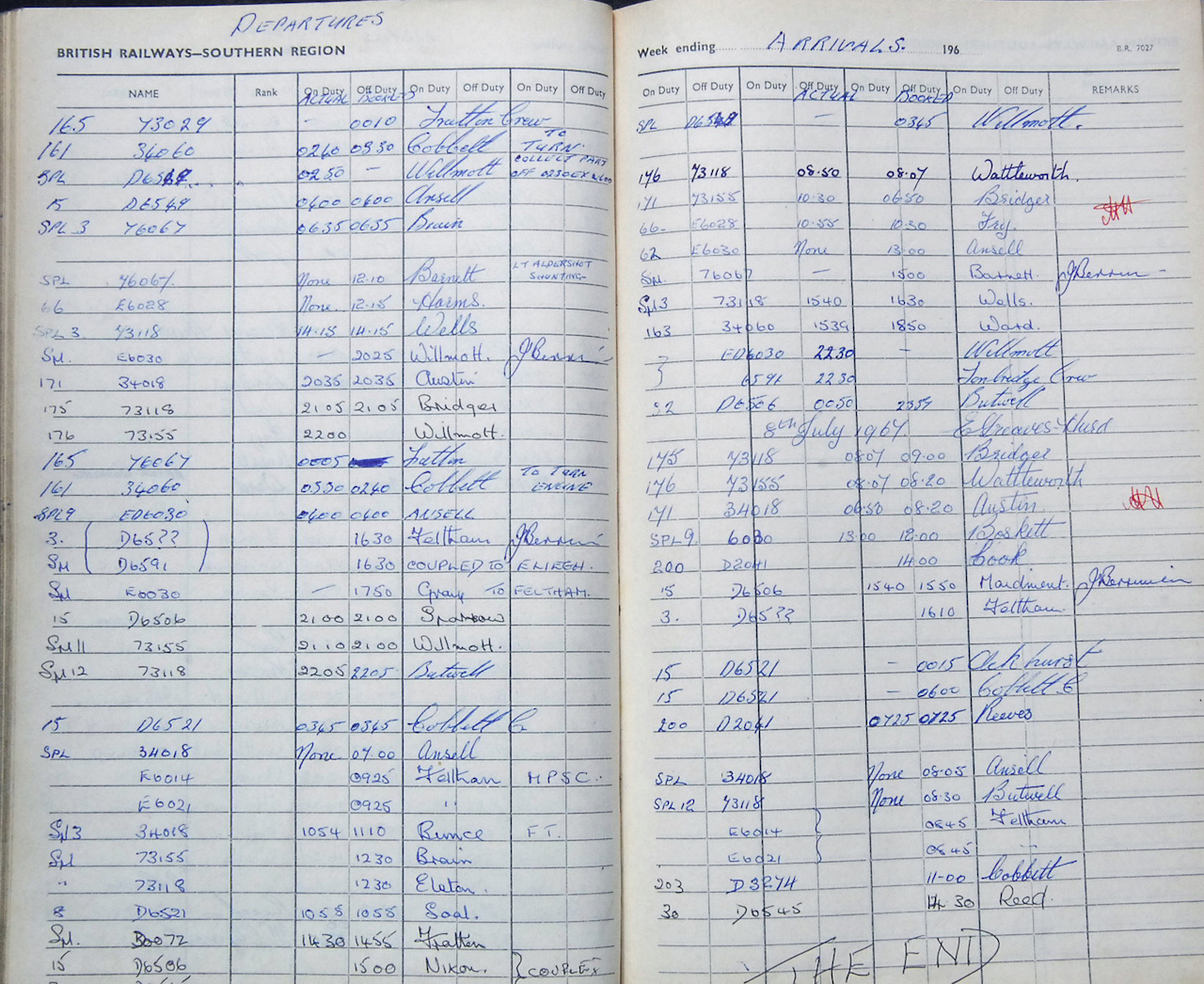
Arrivals and departures of engines to Guildford MPD during the very last days of steam. Note the words at the foot of the right-hand page – ‘THE END’.
To see previous story about the commemorative plaque, click here.
For details of Geoff Burch’s railway book, click here for his website.
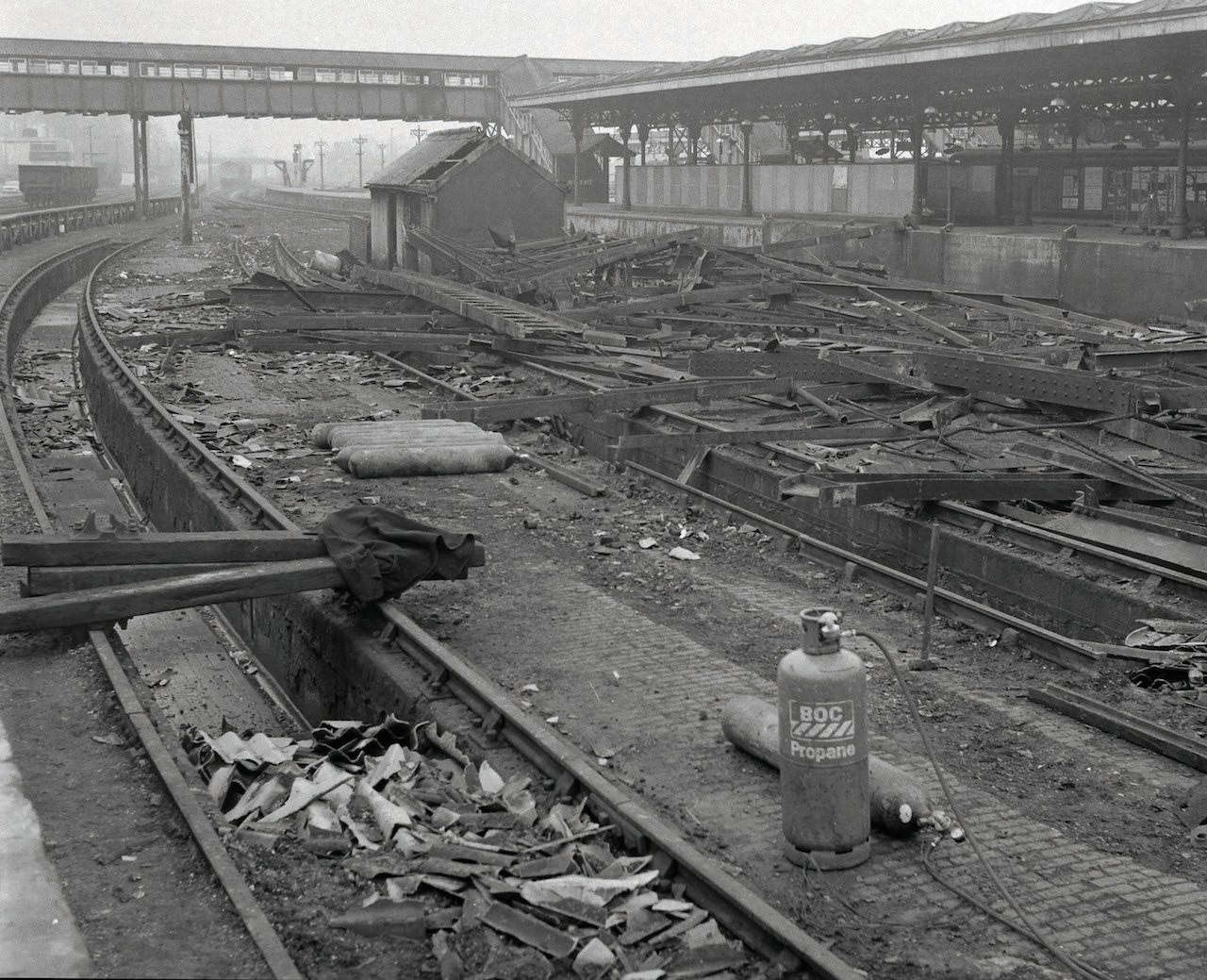
A view after the coaling stage had been demolished, pictured by Dave Salmon. Geoff Burch collection.

The shed being demolished viewed from the Farnham Road bridge. Picture by Dave Salmon. Geoff Burch collection.
Responses to What Really Went On At Guildford As Steam Engines Were Withdrawn
Leave a Comment Cancel replyPlease see our comments policy. All comments are moderated and may take time to appear.
Recent Articles
- Guildford Institute’s Crowdfunding Project for Accessible Toilet in its New Community and Wellbeing Centre
- Letter: Guildford – Another Opportunity Missed?
- Letter: GBC’s Corporate Strategy – Where Is the Ambition?
- My Memories of John Mayall at a Ground-breaking Gig in Guildford Nearly Six Decades Ago
- Westborough HMO Plans ‘Losing the Heart of the Street’ Says Resident
- College Invests to Boost Surrey’s Economy and Close Digital Skills Gap
- Community Lottery Brings Big Wins for Local Charities
- GBC Housing Plan Promises ‘A Vibrant Urban Neighbourhood’ Near Town Centre
- Hospital Pillows ‘Shortage’ at the Royal Surrey
- Updated: Caravans Set Up Camp at Ash Manor School


Recent Comments
- Ian Macpherson on Updated: Main Guildford to Godalming Road Closed Until August 1
- Sara Tokunaga on GBC Housing Plan Promises ‘A Vibrant Urban Neighbourhood’ Near Town Centre
- Michael Courtnage on Daily Mail Online Reports Guildford Has Highest-paid Council Officer
- Alan Judge on GBC Housing Plan Promises ‘A Vibrant Urban Neighbourhood’ Near Town Centre
- John Perkins on GBC Housing Plan Promises ‘A Vibrant Urban Neighbourhood’ Near Town Centre
- S Collins on GBC Housing Plan Promises ‘A Vibrant Urban Neighbourhood’ Near Town Centre
Search in Site
Media Gallery
Dragon Interview: Local Artist Leaves Her Mark At One of England’s Most Historic Buildings
January 21, 2023 / No Comment / Read MoreDragon Interview: Lib Dem Planning Chair: ‘Current Policy Doesn’t Work for Local People’
January 19, 2023 / No Comment / Read MoreA3 Tunnel in Guildford ‘Necessary’ for New Homes, Says Guildford’s MP
January 10, 2023 / No Comment / Read More‘Madness’ for London Road Scheme to Go Ahead Against ‘Huge Opposition’, Says SCC Leader
January 6, 2023 / No Comment / Read MoreCouncillor’s Son Starts Campaign for More Consultation on North Street Plan
December 30, 2022 / No Comment / Read MoreCounty Council Climbs Down Over London Road Works – Further ‘Engagement’ Period Announced
December 14, 2022 / No Comment / Read MoreDragon Interview: GBC Reaction to the Government’s Expected Decision to Relax Housing Targets
December 7, 2022 / No Comment / Read MoreHow Can Our Town Centre Businesses Recover? Watch the Shop Front Debate
May 18, 2020 / No Comment / Read More



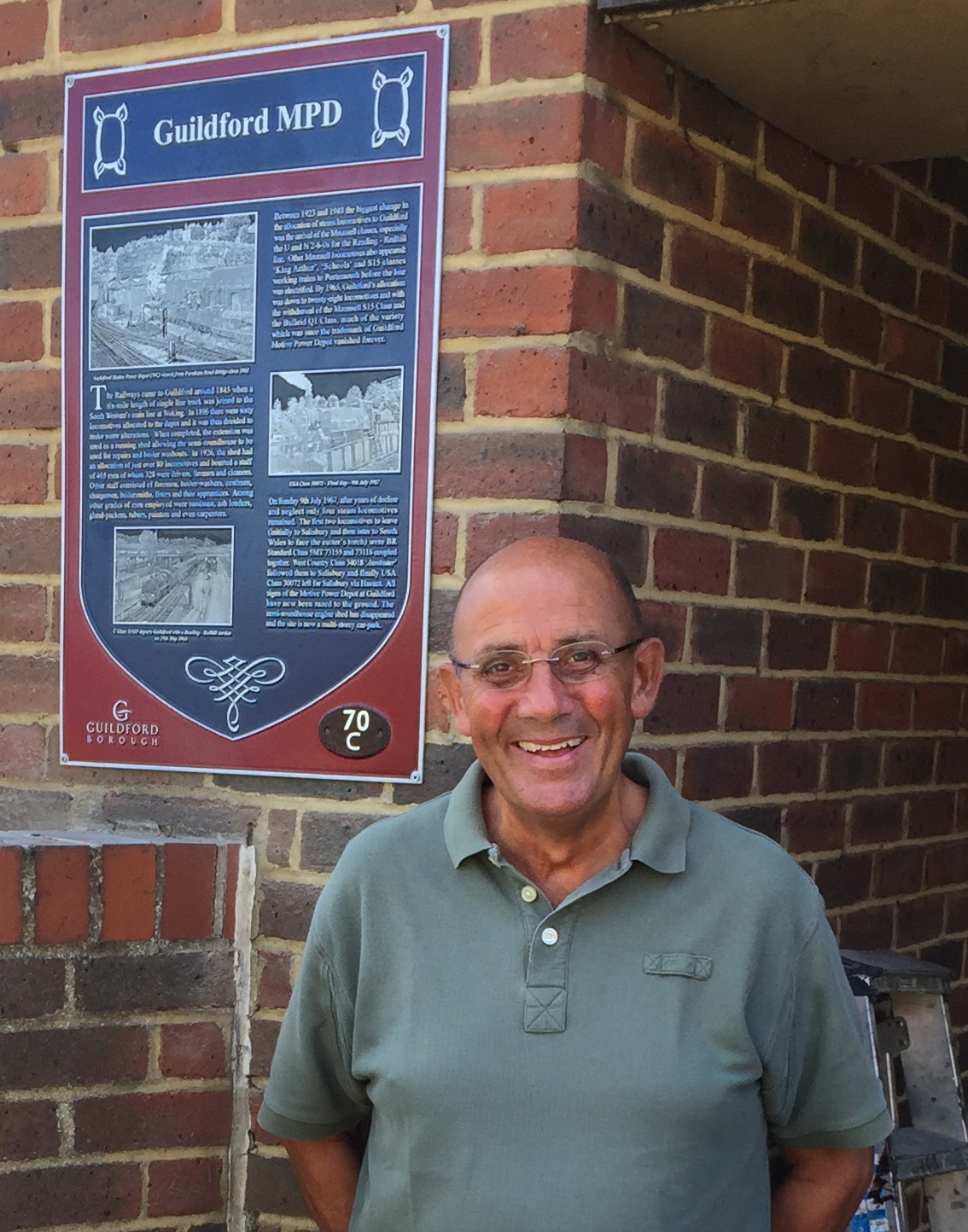
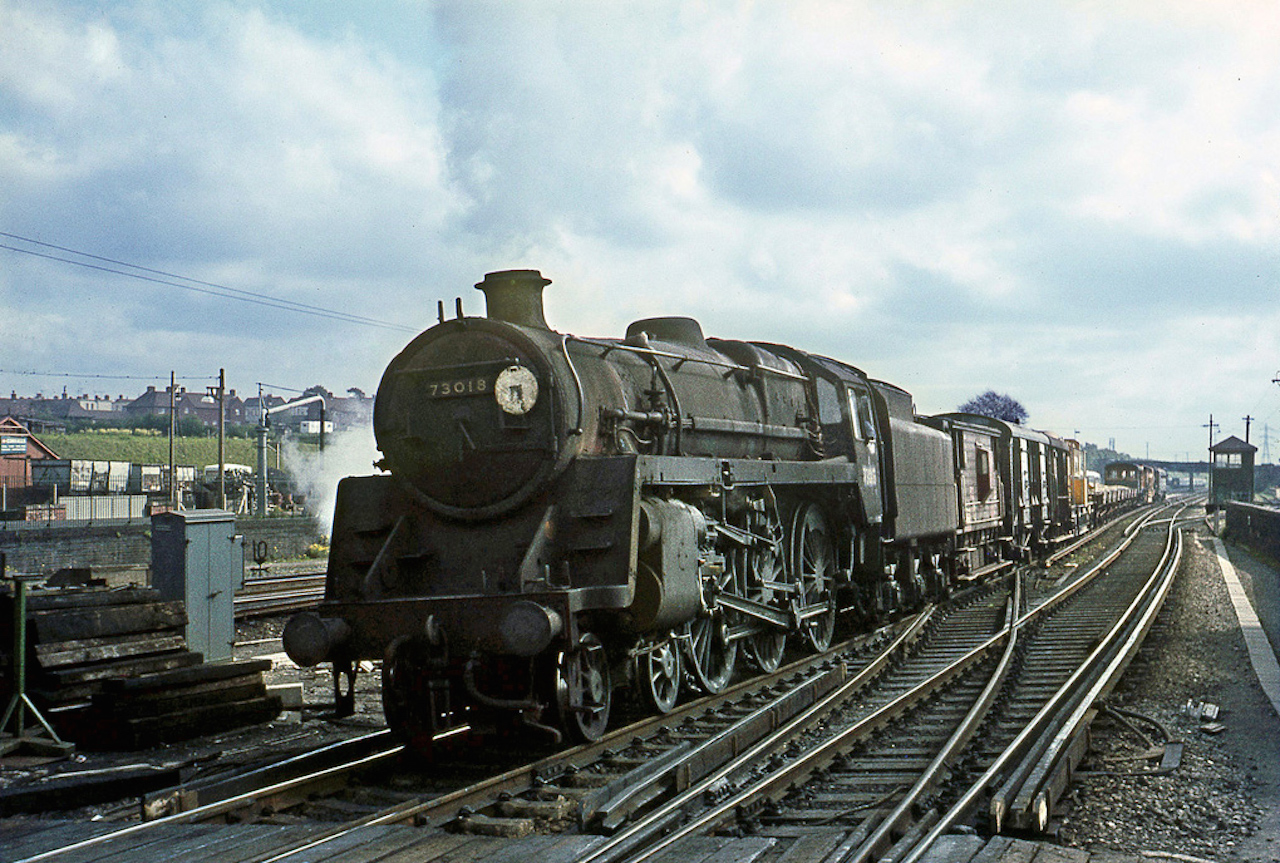
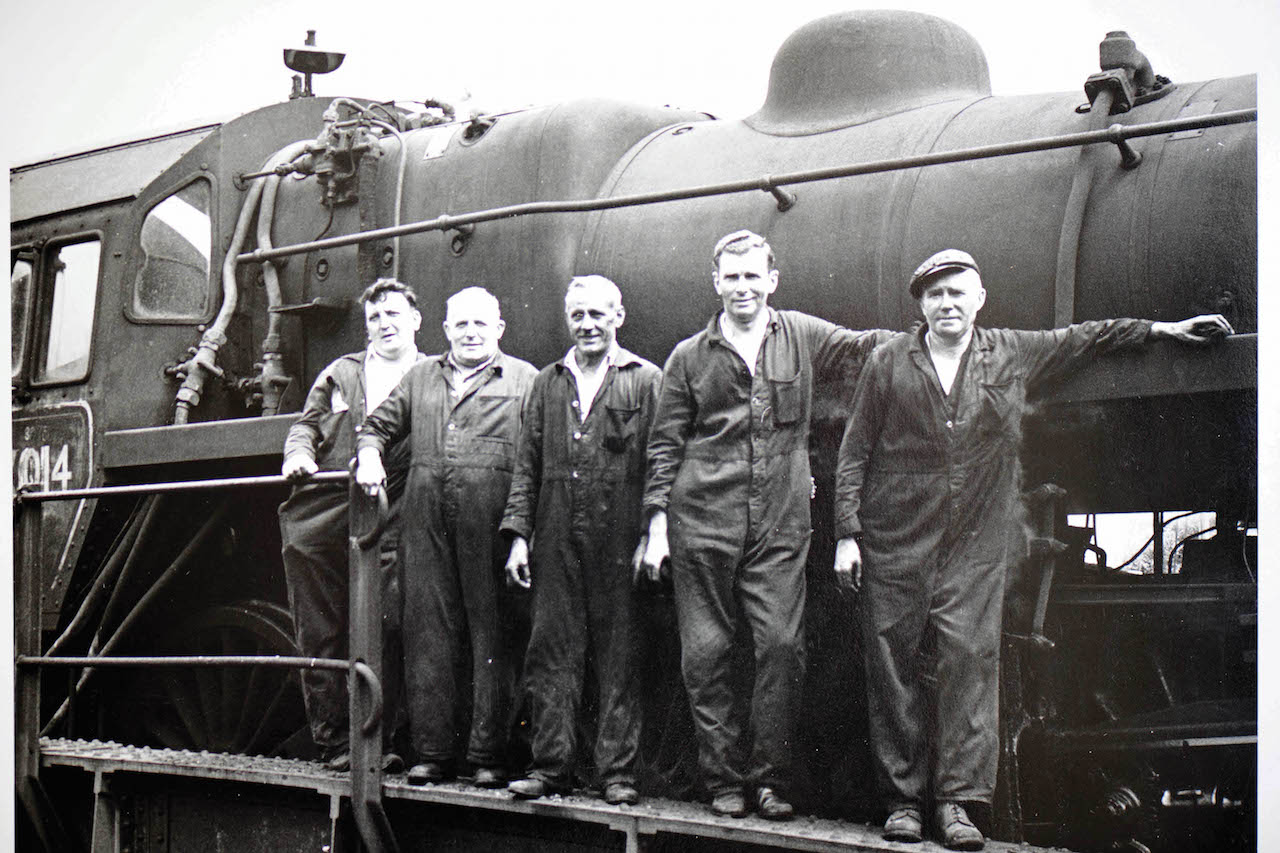
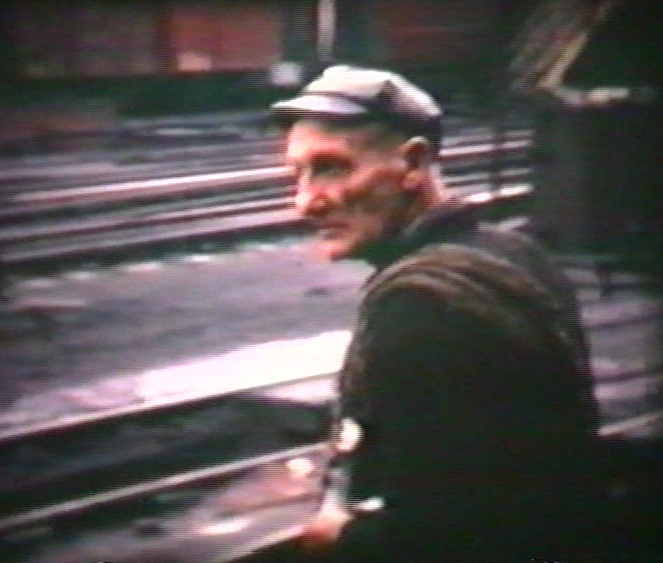
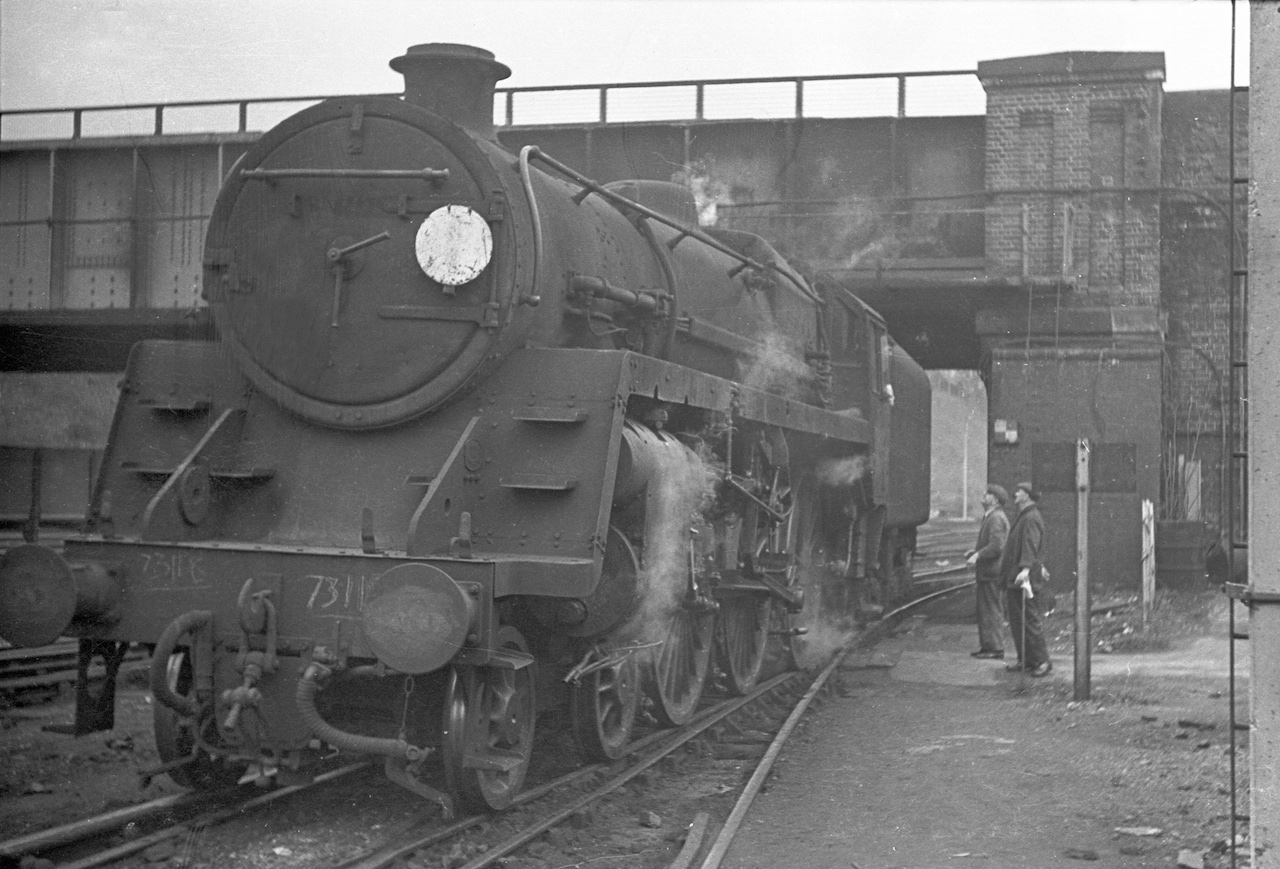
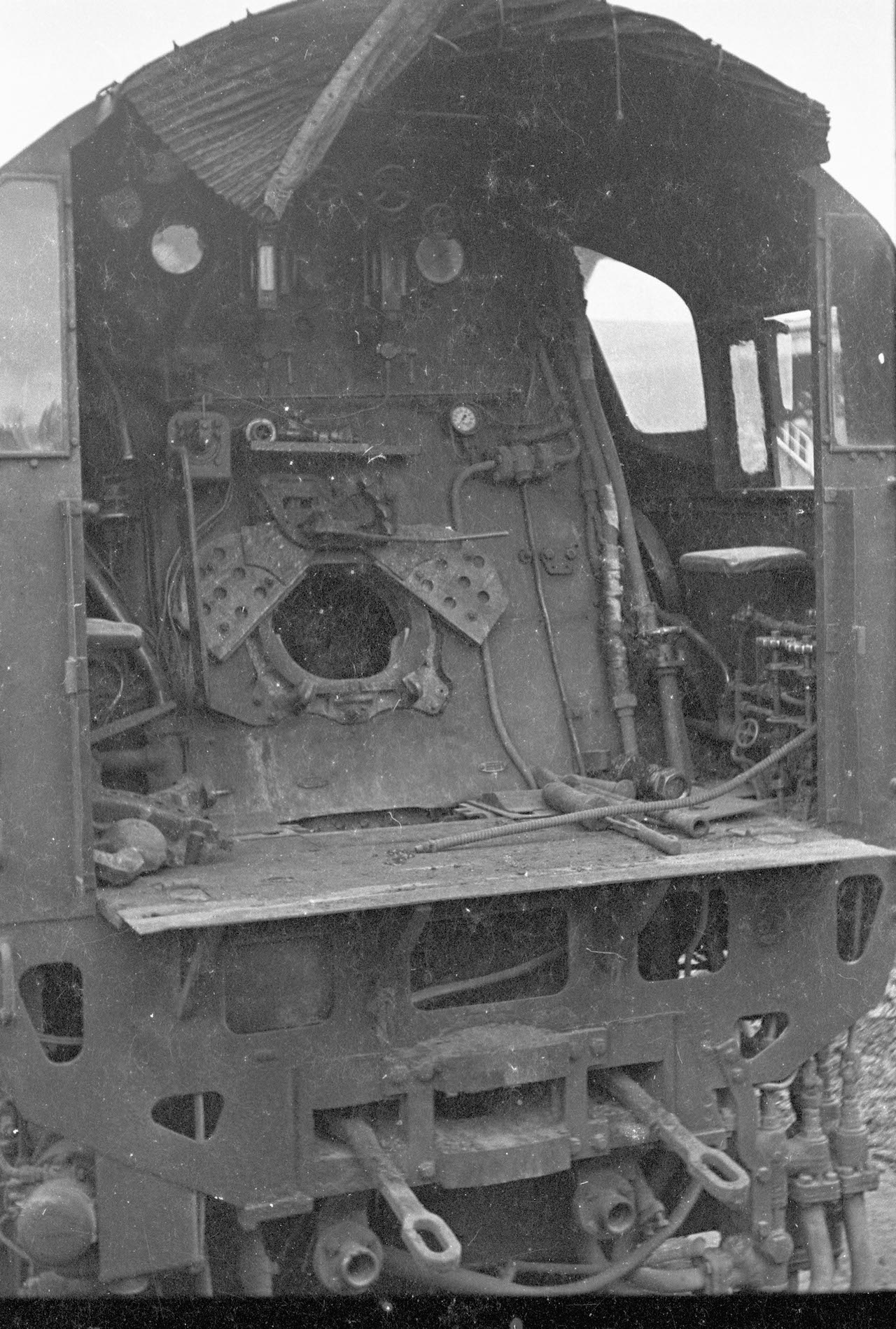
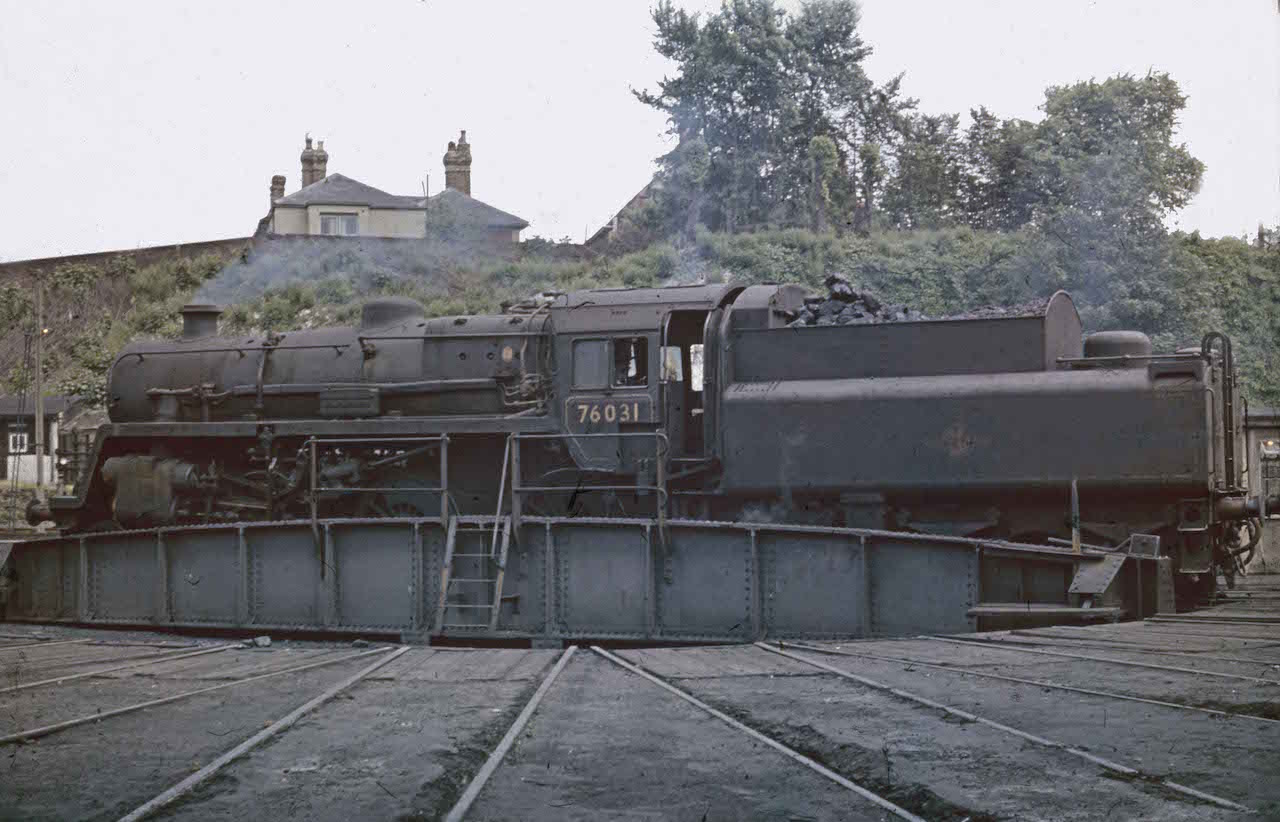
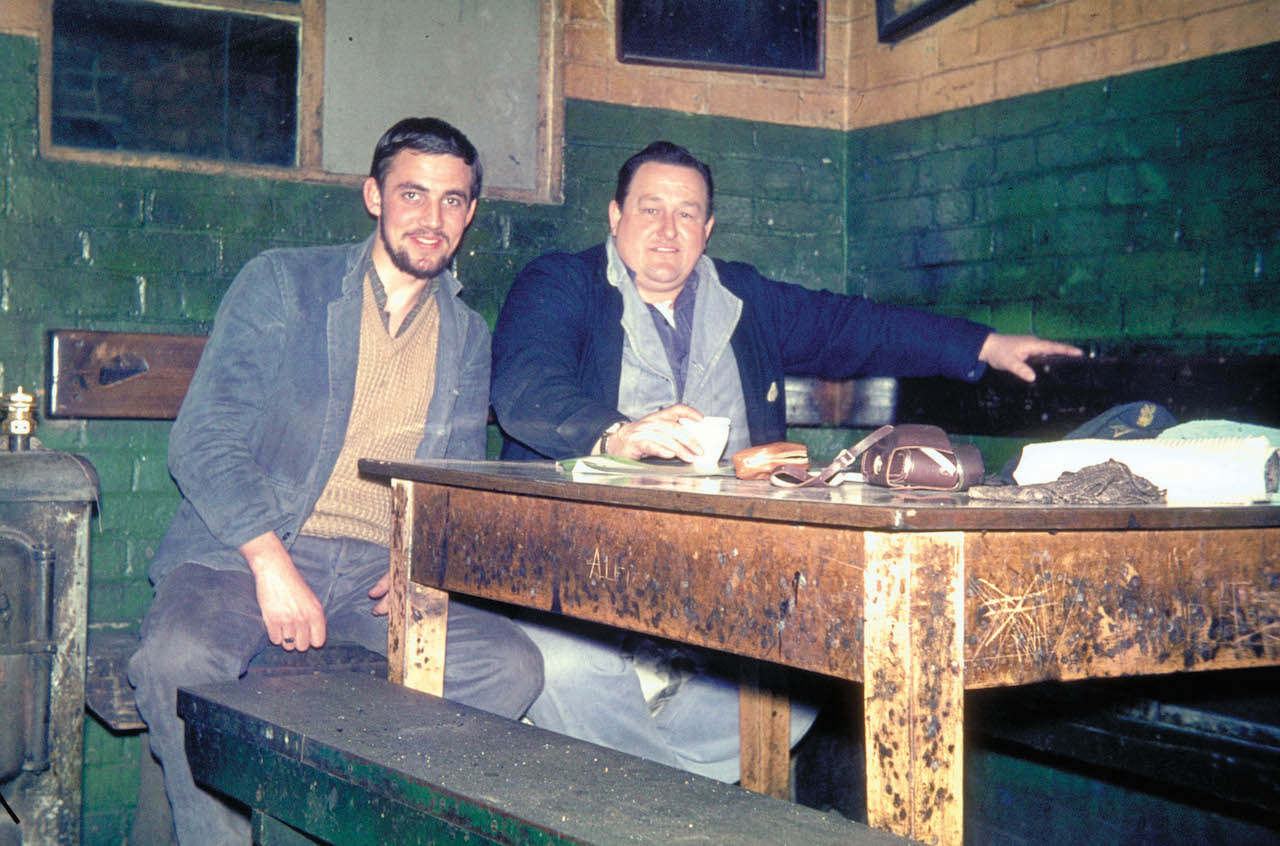
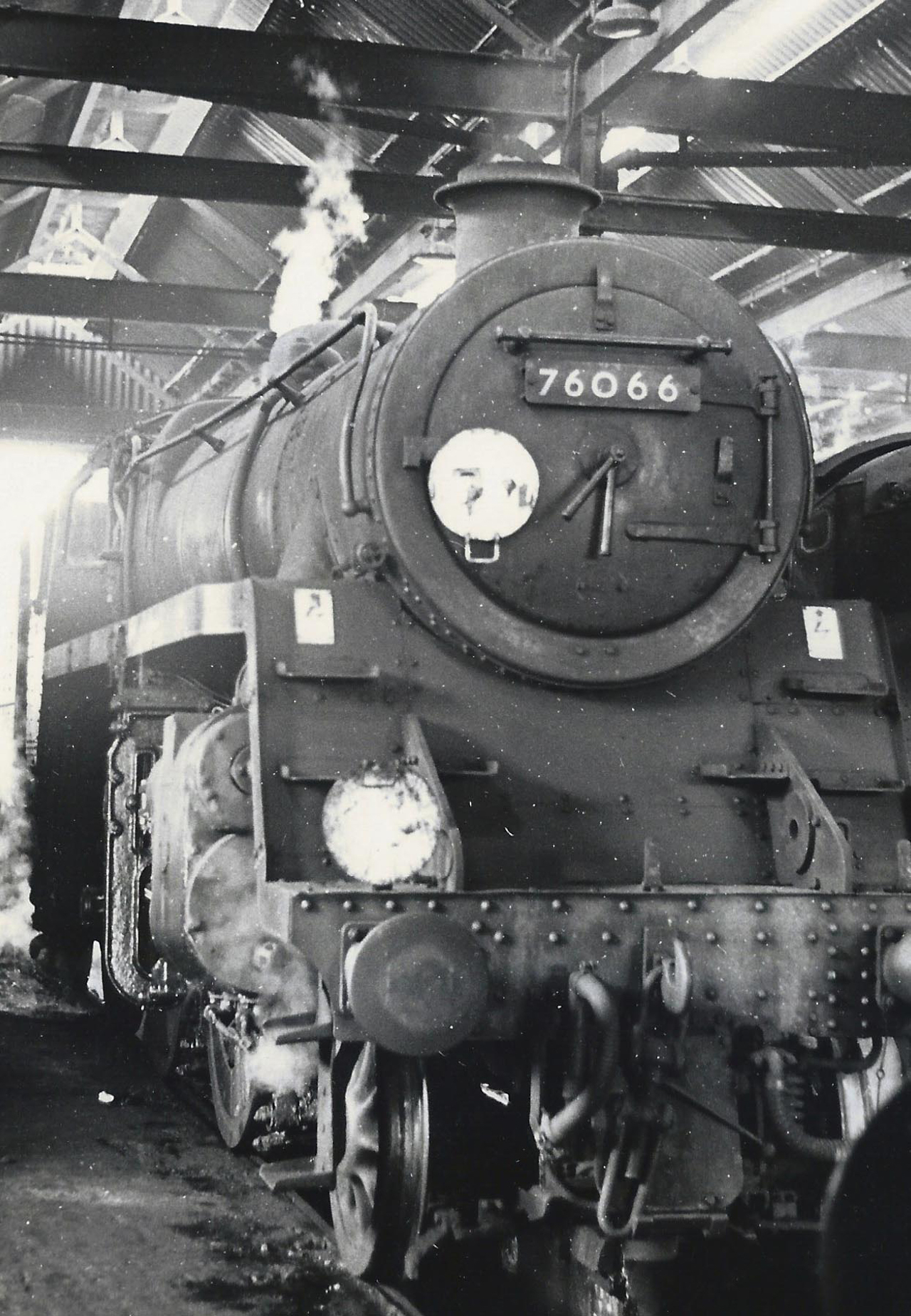



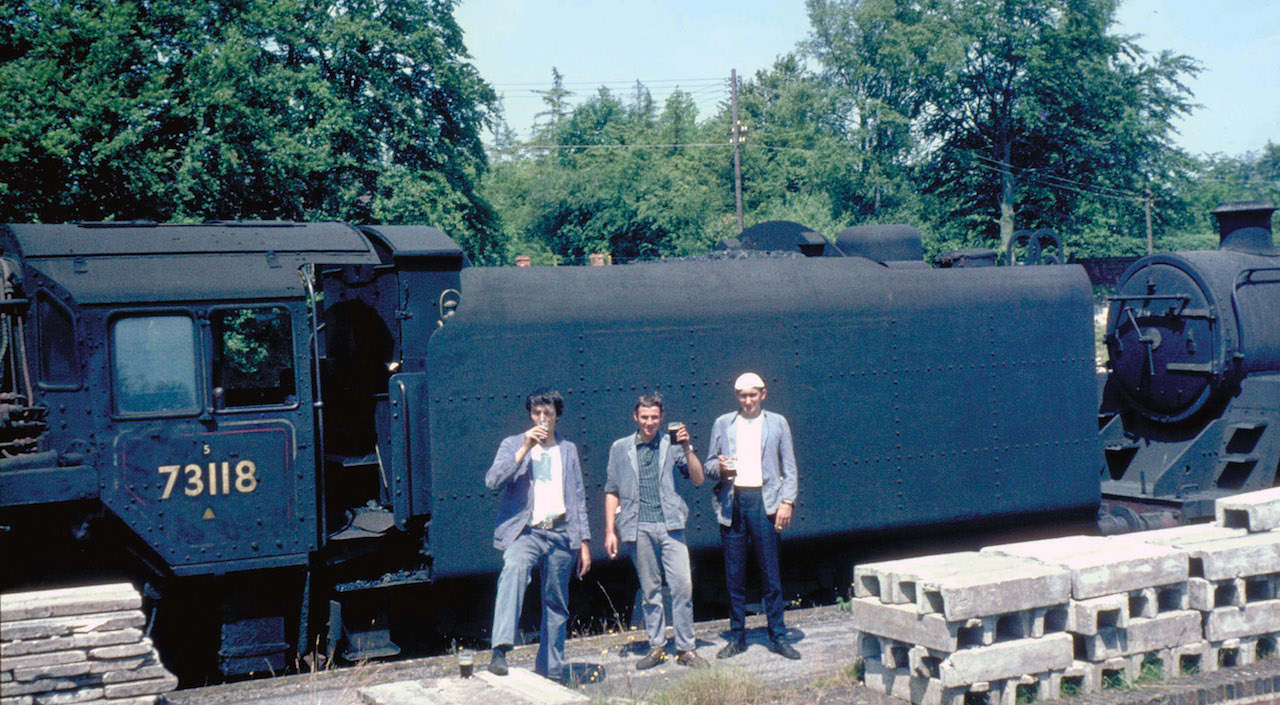
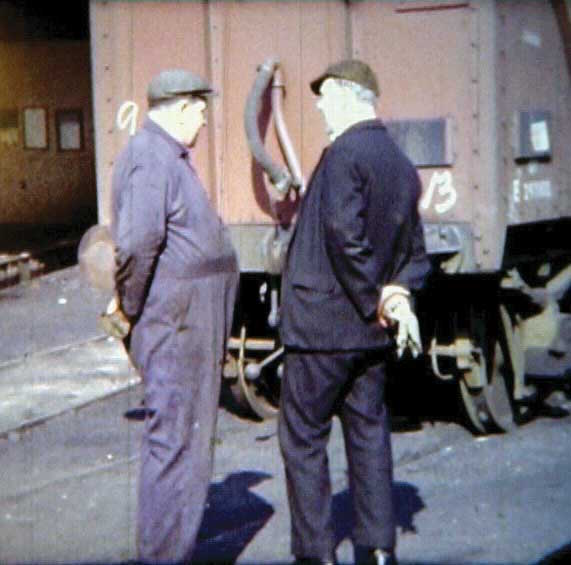
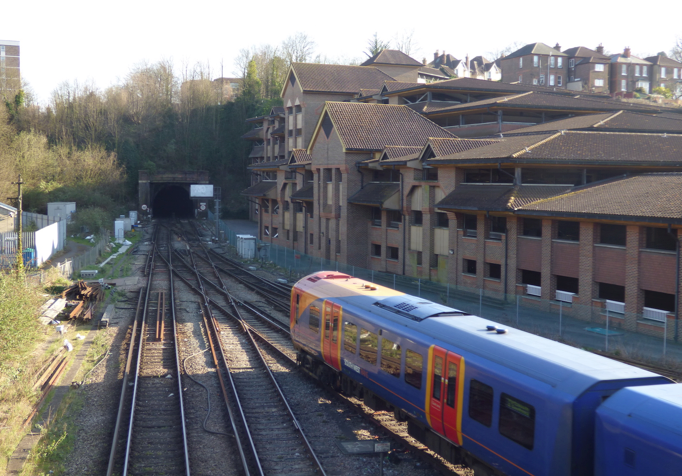






Pete Dorrington
July 6, 2017 at 8:39 am
A very fascinating insight to the working life of a steam shed.
Michael Atkinson
July 6, 2017 at 12:08 pm
Fabulous article with the life of the railways, not just pin-up pictures of locos!
Susie Habgood
July 6, 2017 at 12:50 pm
A fascinating insight. I think, possibly, today’s train drivers do not know they are born!
My great grandfather was a fireman (I believe) working from Guildford.
He died around 1915 after “falling” from a train.
One day I’ll get round to looking into the circumstances of this accident.
Marcus Gibson
July 6, 2017 at 1:48 pm
Yes, an excellent article describing first hand a piece of history in the making. Sad to see so many locos going to their “grave”.
I grew up in the early 1960s and on Esher station, I often watched the ‘Bournemouth Belle’ roar past with a steam engine at full tilt.
Sid Breeden
July 6, 2017 at 3:10 pm
A fabulous sadly past era – thank you for a wonderful and nostalgic story with amazing “normal-life” pictures. Brings back memories of my steam days.
Sid Breeden sent this comment from Western Australia.
David Benbow
July 6, 2017 at 5:21 pm
Excellent records of life at an MPD that was busy and then died like many others. As a 15-year-old in 67, I could never get into the Guildford shed as the staff were as good at chasing trainspotters as driving engines! Thanks for the memories.
Terry Hunter
July 6, 2017 at 8:13 pm
A wonderful article with so many memories of the steam era.
I can remember standing at Woking watching the Bournemouth Belle and other boat trains rattle through at such speeds.
My late father Eric had a lot of photos of old Guildford going back to Victorian times. I am sure had some of the trains, I must have a look.
But thank you for this article, happy memories.
Geoff Burch
July 8, 2017 at 6:45 am
I’d certainly like to see the photographs Terry. Please keep in touch!
Ben Darnton
July 7, 2017 at 12:25 am
An excellent article and I am looking forward to watching the unveiling of the plaque on the Farnham Road railway bridge at 11am this Sunday July 9th, commemorating 50 years since the end of steam.
Geoff Burch
July 8, 2017 at 6:42 am
Thanks for your kind words and look forward to perhaps seeing you all at the unveiling ceremony!
Andrew Miles
July 8, 2017 at 6:11 pm
My late friend Chris Anthony Mitchell was at Guildford on the last day as a fitter and watched 30072 leave.
1972ish he joined the KESR at Rolvenden, worked with him several times as a driver and helped me in ’76 when I had just passed out. His knowledge of Steam Locos was second to none. RIP old friend.
Also his one time Driver George Wright 1939-22/07/87. Another gentleman of the “Iron Road”. RIP.
Adrian Maunders
July 13, 2017 at 3:27 pm
My dad, who was a signalman at Liphook, signalled the USA tank No. 30072 into the down siding there on its final journey.
I have a few photos taken on an Instamatic.
[David Rose replies: Would you be able to scan the pictures (or copy them) and send them to me? Please reply to drosedragon@gmail.com. Thanks.]
Paul Robinson
July 18, 2017 at 3:50 pm
The photo of Clandon signal box brought back memories.
Every weekday my mum used to pick up my dad from Clandon after his commute from Waterloo.
One evening the signalman invited me into the box. I had a wonderful 30 minutes or so in the box before my dad’s train arrived.
Alan Mckie
August 7, 2017 at 12:47 am
The USA tank 30072 is preserved and is at the Keighley and Worth Valley railway.
Bert Gear
July 13, 2018 at 11:56 am
I’m an trustee at Ilfracombe Museum. We have a Ray Ruffell drawling of “Ilfracombe” at Ilfracombe, which we would like to get some prints produced.
Does anyone have any info or contact details of the late Ray Ruffell, so we could get permission or find out about copyright?
Email address: Bertgear@hotmail.com
Mark Tarbutt
July 31, 2018 at 7:21 pm
Thank you Geoff for a wonderful account.
I and a friend would often find my unofficial way into Guildford shed in the last couple of years of steam and so sad that I would not be able to fulfil my life’s ambition to work with steam locos.
The shed staff that we encountered were generally kindly and friendly and did not always throw us out.
I revisited the old shed once it had closed and picked up some bits like gauge glass tubes from the sad remains, I could have cried.
John Austin
November 16, 2018 at 4:55 am
My father worked at the shed for 20 years or more. He was also a member of the breakdown gang his name was Harold Austin, although known as Alan.
Peter Freeman
January 20, 2019 at 11:55 pm
Ray Ruffell and I went to school together, and train spotting was a big thing, especially during the summer holidays. He took a ton of pictures.
He lived in Little Sandhurst, and the stop off in your article was just up the road from where I lived. He was a fireman on the Southern Region after he left school.
He travelled all over the country, tracking railway stuff when on his school holidays.
I am sorry to hear he is no longer with us, thinking about him, it takes me back a bit.
Michael Day
May 27, 2019 at 7:07 pm
I really enjoyed reading about your time at Guildford she’d bought back a lot of memories for me. I was a fireman at Feltham/ second man until it closed in 1969. Loved my time on the railway one big happy family no matter what depot you came from.
Michael Avery
May 27, 2019 at 7:17 pm
Re Ron Summerfield’s pictures at Guildford locomotive shed, I think the fireman’s name was ? Granger.
Phil Kelly
September 28, 2020 at 3:21 am
I too was able to go round the shed unofficially pretty well every day after school in the last two years of steam and, like Mark Tarbutt, also found the men there very kindly, when my presence was noticed.
I used to clamber down the chalk embankment at the side of the shed and go round to the opening where the roundhouse meets the shed lines. The window of the foreman’s office on that side was far too dirty to be able to see intruders. Certainly the foreman’s office was not so keen on train-spotters like me, though in earlier years I did sometimes get chased up the steps.
I kept a log of what was in the shed and in the station for the last couple of years of steam. Just looking through it really takes me back.